- International edition
- Australia edition
- Europe edition


‘Here for the heat’: Death Valley sizzles, but the tourism doesn’t stop
National park has seen remarkable temperatures this summer with some intentionally, and some accidentally, caught in the heatwave
Around every desolate curve of road in Death Valley national park, official signs warn of peril.
“Heat kills!” cautioned one flyer at popular Zabriskie Point, as tourists streamed by on Thursday afternoon to marvel at a dramatic vista beyond. A photo of a red tombstone completed the dire message: “Don’t become a Death Valley victim.”
Death Valley is hardly a stranger to elemental extremes and has long attracted those drawn to the edge. The park bills itself as the “hottest, driest and lowest” – the hottest place on Earth, the driest place in the United States and the lowest point in North America. Visitors make the trek there from around the world to experience its surreal, lunar-looking landscapes and dramatic temperature swings. A famously difficult ultramarathon, the Badwater 135, sees runners race across the cracked salt flat of the park each July.
But even by Death Valley standards, this has been a remarkable summer. The park, which set the world record for the hottest air temperature (a withering 134F, or 56.7C) more than a century ago, approached modern heat records this week. An excessive heat warning, involving daytime temperatures “well over” 120F and night-time averages still hovering around the triple digits, remains in effect until Sunday.
The grim weather warnings come at a critical time. Two people have died in Death Valley amid the recent heatwave, including a 71-year-old man who collapsed this Tuesday after hiking near Golden Canyon, where a sign reminded visitors that in a heat-related emergency, “rescue in time is not a guarantee”. Earlier this month, a 65-year-old was found dead in his car from “ apparent heat illness ”.
The temperature in Death Valley will also probably become even more intense in the era of climate crisis; nine of the park’s 10 hottest summers have been in the last 15 years, the visitor center reports. “With global warming, such temperatures are becoming more and more likely to occur,” Randy Ceverny, of the World Meteorological Organization, told the Guardian this week .
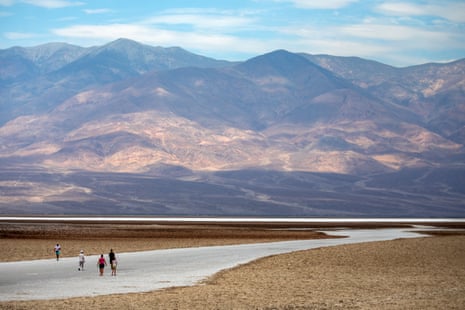
Still, many Death Valley visitors have been undeterred by the blistering heat this month – and some are even choosing to visit for that exact reason.
This week, tourists congregated around a display thermometer in front of the Furnace Creek Visitor Center, posing for photos as the temperature ticked from 123F to 124F. The impenetrable wall of desert heat, a shock to the system after being inside a chilled car, forced each group into the shelter of the visitor center after only a minute or two.
Paul Blum and his family, who were visiting the park from France, said they planned their trip months ago to take advantage of summer holidays. But the night before their drive to Death Valley from Las Vegas, Blum had a brief moment of hesitation.
“I thought, ‘Is it reasonable to drive through Death Valley with two kids?’” he said. “But it’s a new car, so I hope so. With an old car I wouldn’t try.”
Tourism heats up with temperatures
At Last Kind Words Saloon, one of the only watering holes in the national park’s central hub of Furnace Creek, the stiff air conditioning offers a reprieve from the sun. As the day’s heat rested around 120F on Thursday afternoon, visitors began to trickle in for steaks and cold drinks.
A server at the saloon, Alan California (“Alan from California,” he said, explaining the name displayed on his name tag), said that earlier this summer, business seemed to be slower.
“But since the heat has picked up drastically lately, we’ve actually gotten busier,” he said of the past week. “For some reason, people want to be out here for the heat.”
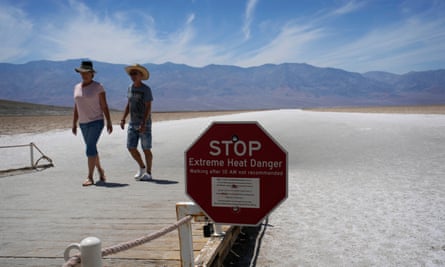
Alan, who stays in Furnace Creek for part of the week and commutes back to his home an hour away the rest of the time, said he makes sure to stay indoors during midday. “People just don’t know how the heat can affect you if you’re not used to it,” he said.
While it may seem ill-advised to experience the hottest place on Earth during the hottest season of the year, Abby Wines, a Death Valley spokesperson and park ranger, said that March, April, July and August are Death Valley’s busiest times, with roughly 100,000 visitors each month.
But those who choose to visit this time of year do so for several different reasons, she said. The first category of visitors is made up of tourists from other countries, like the Blum family from France, who are merely planning a summer vacation and wind up in Death Valley during a heatwave.
“They’ve planned their vacation months in advance, so they couldn’t say, ‘Oh, [the park] might break a heat record on this particular weekend, let’s go then,’” Wines said.
And then there are the heat-seekers.
“Some people do come intentionally when the news says, ‘Death Valley might break a record,’” she said. This past week, for instance, a 52-year-old man wearing a Darth Vader costume embarked on a one-mile run through the park, an almost annual feat that he saves for the hottest day of the year, at the hottest time of the day.
Although Wines said she wouldn’t tell visitors to stay away entirely, she warns tourists to “take the heat seriously” and take many precautions, such as staying close to a cool shelter and avoiding going out during the hottest part of the day.
“Rescue is impossible when it’s extremely hot,” she said. If a visitor chooses to hike far away from a trailhead and ends up collapsing, she added, that puts the park’s employees, who would need to hike after them, in danger. Rescue helicopters also can’t fly in extreme heat because of how it changes air density, as was the case with the 71-year-old hiker who died this week, officials said.
“A number one rule of safety,” Wines said of rescue missions, “is to make sure it’s safe enough before you put other people at risk.”
Braving the heat
Back at the visitor center, Zhebeau Beasley from Ohio landed more firmly in the category of visitor who booked their trip earlier and then ended up in a heatwave.
“People [told me], ‘Good luck out there man, it’s supposed to be record heat,’” he said. “It kind of caught us off guard the first day we stepped out into it.”
Certain activities, like hiking, are off the table for Beasley while he’s visiting the national park.
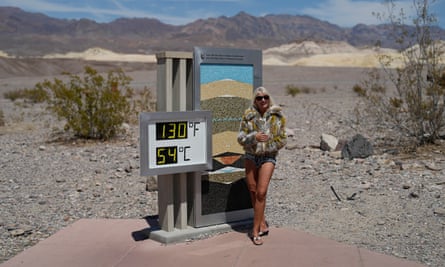
“Who in their right mind would hike this time of the year? Other than David Goggins, I don’t know who else would do it,” he said, referencing a runner who has completed the Badwater 135 several times.
And despite the near record-breaking temperatures, the national park buzzed with activity late into the day on Thursday. Families bought T-shirts and bottles of water at the visitor center and couples braved the heat long enough to get out of their cars at designated overlooks.
After all, for many people the trip was months, or years, in the making. Visitor Abdul Munifi said he and a handful of his family members had flown about 16 hours from the Arabian Peninsula to be there.
“Feels like home,” Munifi joked, looking out from Zabriskie Point, which required walking up a dauntingly steep path into the afternoon sun. Visible heat waves rippled the air. “I think we’re used to it.”
This article was amended on 24 July 2023 to correct the spelling of Abdul Munifi’s name.
- Extreme weather
Most viewed
Extreme heat tourism in Death Valley: ‘It’s too much, it’s just unbearable!’
The prospect of record-breaking heat in the california national park has drawn floods of european tourists exposing themselves to the dangers of a uniquely aggressive ecosystem.

Heather can’t contain a smile as she mentions how many customers this summer’s record-breaking temperatures have brought her. “We sold twice as much as usual over the weekend,” says the manager of the souvenir store in Death Valley, the hottest place in the United States and the record-holder for the highest temperature ever recorded on the planet. Heather speaks with pride about the boom that the Furnace Creek community, on the border between California and Nevada , has witnessed due to the possibility of the 1913 record of 134º F (56.7º C) being beaten. “In the end it didn’t happen, but it was very exciting. We even had a little protest and everything!” she says.
The demonstration she refers to was held by a small group of environmental activists who came to shout “Happy Death Day!” at tourists taking selfies next to a large digital thermometer. The event provided some life in an area that generally lacks it. When the sun is in the sky, this huge nature reserve is a ghostly wasteland. Roadside signs warn of the extreme danger posed by the heat. On hiking trails, the message is even more direct. “HEAT KILLS,” reads a large banner that advises against walking outdoors after 10 a.m. “Come prepared to survive,” reads one of the National Park Service’s warnings.
We were curious about the extreme heat; we wanted to experience it once in our lives” Joaquín Rivera, American tourist
Joaquín and Rebeca Rivera were among the tourists who visited the area during the recent heatwave, attracted by the prospect of witnessing a world record. Originally from San Diego, they decided to modify their route to Las Vegas after reading in the press that the previous record was in danger. “We were curious about the extreme heat; we wanted to experience it once in our lives,” says 62-year-old Joaquín at the national park’s visitor center. Their documentation of the trip was eventually limited to taking pictures of the thermometer on the car’s dashboard, after they verified that it was too hot to go outdoors.
Still, there are those who are determined to try. The park rangers explain that in summer the number of U.S. visitors naturally decreases and the bulk of the tourists are European . On Tuesday, a group of 93 French people visited the park. Cirile and Juliette, two students originally from Grenoble, approached the Mesquite dunes, one of the park’s most famous sites. “It’s too much, it’s simply unbearable!” said Cirile. She elected to remain near the car, rather than approach the huge mountains of golden sand, a picture postcard of this desert landscape. Juliette, her face tomato-red under a cap, tried to provide an opinion, but the words wouldn’t come out: “I can’t speak English in this heat,” she said.
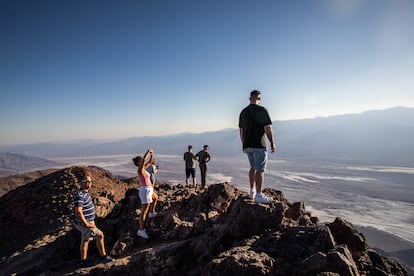
A fragile ecosystem, under threat
Death Valley officially recorded the highest temperature on the planet at Furnace Creek on July 10, 1913 , when the thermometer supposedly reached 134º F (56.7º C). However, there are meteorologists and historians who dispute the veracity of this measurement, taken only two years after records began. The Weather Company, operated by IBM, claims that the highest recorded ambient temperature on Earth indeed in Furnace Creek, but in July 2021. For a couple of decades now, satellites equipped with NASA technology that allows high-resolution imaging have captured the Lut Desert in Iran and the Sonora Desert in Mexico reaching 80º C (176ºF) on their surfaces. These sites, however, have cold nights, while in Death Valley, it is 46ºC (114.8ºF) at 10 p.m.
Climate change, however, is making it increasingly likely that record temperatures will be reached or broken . In 2020, the temperature exceeded 37.7ºC (99.8ºF) in Death Valley for 169 days. In 2021, there were 11 days at above 51.6ºC (124.8ºF), according to the National Weather Service.
Rising temperatures threaten to end the valley’s already fragile ecosystem. The heat has caused an explosion in numbers of a beetle that is a pest to the area’s thousand-year-old pine trees, which have been barely surviving California’s chronic drought . Tree mortality has increased 70% over the last decade. The bird population has also declined.
[People come] with a false sense of security. They believe that having a cell phone and a vehicle is enough, but cars can break down and in most of the park there is no cell signal” Park Ranger Abby Snow
The valley has other attractive features for adventurers. A point known as the Badwater Basin is the lowest in North America at 282 feet (86 meters) below sea level. The region also has the driest land in the United States. On average, only five centimeters of rain falls per year, a phenomenon that is compounded by hot air that burns skin and accelerates the evaporation process in humans and animals. In the summer and with the wind blowing, a person can lose up to seven liters of water sitting in the shade, where the temperature does not drop below 46ºC (114.8ºF).
Park Ranger Abby Snow says that many visitors to Death Valley come with “a false sense of security. They believe that having a cell phone and a vehicle is enough, but cars can break down and in most of the park there is no cell signal.”
Reserve managers recommend at least four gallons (15 liters) of drinking water per person. According to National Park Service figures, there are between one and three heat-related deaths each summer. Last Tuesday, a 77-year-old man from Las Vegas collapsed outside a restroom in Golden Canyon, one of the park’s hiking trails. It is believed that his death was due to heat stroke when the thermometer reached 51ºC (123.8ºF). If confirmed, it will mark the second heat-related death of the season.

Death Valley can surprise even the most prepared visitor. On August 7, 2012, Michael Popov, an experienced ultramarathon runner, died while training for a 160-kilometer (100-mile) race. The 34-year-old Russian athlete set out at around 2 p.m. in temperatures above 50ºC (122ºF) with the intention of running cross-country for about 10 kilometers. Although he had completed races in the past that stretched to more than 60 hours, the desert was enough to defeat him in two and a half hours. He was found on a paved road, conscious, but delirious and aggressive. His heart stopped minutes later. Doctors determined that he had died of asphyxia due to a hemorrhage in his lungs caused by the heat. The ultramarathon community believes that his fatal mistake was to have run the course with two liters of water, when athletes need at least two to three liters per hour to avoid succumbing to heat.
Sign up for our weekly newsletter to get more English-language news coverage from EL PAÍS USA Edition
More information

Phoenix hits at least 110 for 19th straight day, breaking US city records in worldwide heat wave
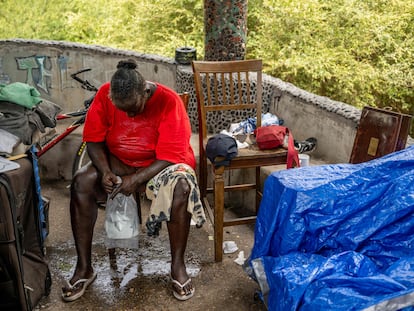
Extreme heat scorches one in three Americans
Archived in.
- Francés online
- Inglés online
- Italiano online
- Alemán online
- Crucigramas & Juegos

A Death Valley hotel almost shut down — but an influx of 'extreme heat tourists' have helped it survive
- Heat waves and wildfires could upend tourism to popular summer vacation spots around the globe.
- Meanwhile, "extreme heat tourists" are flocking to Death Valley, the hottest place on Earth.
- But many visitors arrive unprepared for the desert, the president of a local hotel told Insider.
Heat waves and wildfires threaten to upend tourism to popular vacation spots around the globe. But for many tourists traveling to Death Valley, a desert region in California known as the hottest place on Earth, triple-digit temperatures are just another thing to cross off their bucket lists.
When relentless heatwaves blanketed the Southwest in July (reported to be Earth's hottest month on record), tourists flocked to Furnace Creek, an unincorporated community in Death Valley, to snap photos in front of a digital thermometer displayed at the town's visitor center.
"They're extreme heat tourists," Fred Conboy, the president of the Board of Directors for Amargosa Opera House , a historic hotel in Death Valley Junction, told Insider. "For them, it's a badge of honor almost, to have their picture taken next to that thermometer."
In recent summers, Furnace Creek has recorded temperatures hot enough to cook a medium-rare steak. In July 2021 and August 2020, the town reached 130 degrees, just four points shy of the world record set back in 1913.
"They try hard to predict what time of the day it's going to reach 130," Conboy said. "If it's only 128 or 129, sometimes they're disappointed."
Most people wouldn't dare step foot outside in that kind of heat. But it hasn't deterred travelers like William Cadwallader, a Las Vegas resident who told the Associated Press in July that he visits Death Valley in the summer for the bragging rights of being to the hottest place on Earth.
Related stories
"I just want to go to a place, sort of like Mount Everest, to say, you know, you did it," he told the outlet.
Some tourists are unprepared for the desert's extreme heat
Amargosa Opera House, one of the more affordable hotels near Death Valley National Park, offers spartan accommodations without televisions or phones. During the summer, it typically has 10 to 12 out of its 15 rooms booked at a time, Conboy told Insider.
After the hotel nearly shut down for good during the pandemic, the steady stream of tourists is a welcome, if perplexing, sight for Conboy and the staff. But chasing record temperatures, or "climate change gawking," as Fortune Magazine described it, is a dangerous game to play — and many tourists underestimate the risks.
When visitors arrive, the first thing they do is ask where they can buy water, Conboy said. The closest store is miles away, so the hotel keeps a five-gallon water jug in the lobby that's quickly drained.
"So few people are well prepared when they come out to the desert," he said. "It's 115 or 120 degrees, and they don't have water."
Two tourists have died in Death Valley this summer, according to the National Park Service — both on days when temperatures reached above 120 degrees. To avoid the hottest times of the day, rangers recommend planning any activities before 10 a.m. or after 4 p.m.
The triple-digit heat is made even more dangerous by how rural Death Valley is. There's only a handful of places to get food and a total of three gas stations nearby. Much of the national park doesn't have reliable cell service and is hours away from the nearest hospital.
In the words of the National Park Service : visitors must "travel prepared to survive."
"You've got to take care of yourself if you're going to be out in the heat," Conboy said. "Otherwise, your brain is going to shut down."
Watch: California braces itself for the hottest September on record
- Main content
Weather | Record-setting heat draws tourists to Death Valley
Share this:.
- Click to share on Facebook (Opens in new window)
- Click to share on Twitter (Opens in new window)
- Click to print (Opens in new window)
- Click to email a link to a friend (Opens in new window)
- Click to share on Reddit (Opens in new window)
Today's e-Edition
- Latest News
- Environment
- Transportation
This weekend, the temperatures could climb past 130 F

DEATH VALLEY NATIONAL PARK — As uninviting as it sounds, Death Valley National Park beckons.
Even as the already extreme temperatures are forecast to climb even higher, potentially topping records amid a major U.S. heat wave, tourists are arriving at this infamous desert landscape on the California-Nevada border.
Daniel Jusehus snapped a photo earlier this week of a famed thermometer outside the aptly named Furnace Creek Visitor Center after challenging himself to a run in the sweltering heat.
“I was really noticing, you know, I didn’t feel so hot, but my body was working really hard to cool myself,” said Jusehus, an active runner who was visiting from Germany. His photo showed the thermometer reading at 120 degrees Fahrenheit (48.8 degrees Celsius).
Most visitors at this time of year make it only a short distance to any site in the park — which bills itself as the lowest, hottest and driest place on Earth — before returning to the sanctuary of an air-conditioned vehicle.
This weekend, the temperatures could climb past 130 F (54.4 C), but that likely won’t deter some willing to brave the heat. Signs at hiking trails advise against venturing out after 10 a.m., though nighttime temperatures are still expected to be over 90 F (32.2 C). The hottest temperature recorded at Death Valley was 134 F (56.6 C) in July 1913, according to the National Park Service.
Other parks have long-standing warnings for hikers. At Grand Canyon National Park in Arizona, officials are cautioning people to stay off the trails for most of the day in the inner canyon, where temperatures can be 20 degrees hotter than the rim.
In west Texas, Big Bend National Park near the Rio Grande is expected to be at least 110 F (43.3 C). The National Weather Service has said it’s best to just stay off the trails in the afternoon.
The precautions vary across parks and landscapes, said Cynthia Hernandez, a park service spokesperson. Certain trails might be closed if conditions are too dangerous. Alerts and restrictions are posted on websites for individual parks, Hernandez said.
Preliminary information form the park service shows at least four people have died this year from heat-related causes across the 424 national park sites. That includes a 65-year-old man from San Diego who was found dead in his vehicle at Death Valley earlier this month, according to a news release.
Death Valley National Park emphasizes self-reliance over expectations of rescue. While rangers patrol park roads and can assist motorists in distress, there’s no guarantee lost tourists will get aid in time.
More than 1.1 million people annually visit the desert park, which sits over a portion of the California-Nevada border west of Las Vegas. At 5,346 square miles (13,848 square kilometers), it’s the largest national park in the Lower 48. About one-fifth of the visitors come in June, July and August.
Many are tempted to explore, even after the suggested cutoff times. Physical activity can make the heat even more unbearable and leave people feeling exhausted. Sunbaked rocks, sand and soil still radiate after sunset.
“It does feel like the sun has gone through your skin and is getting into your bones,” said park Ranger Nichole Andler.
Others mentioned feeling their eyes drying out from the hot wind sweeping through the valley.
“It’s very hot. I mean, especially when there’s a breeze, you would think that maybe that would give you some slight relief from the heat, but it just really does feel like an air blow dryer just going back in your face,” said Alessia Dempster, who was visiting from Edinburgh, Scotland.
Death Valley is a narrow, 282-foot (86-meter) basin that is below sea level but situated among high, steep mountain ranges, according to the park service’s website. The bone-dry air and meager plant coverage allows sunlight to heat up the desert surface. The rocks and the soil emit all that heat in turn, which then becomes trapped in the depths of the valley.
The park’s brownish hills feature signage saying “heat kills” and other messaging, such as a Stovepipe Wells sign warning travelers of the “Savage Summer Sun.”
Still, there are several awe-inspiring sites that draw tourists. Badwater Basin, made up of salt flats, is considered the lowest point in all of North America. The eye-opening 600-foot (183-meter) Ubehebe Crater dates back over 2,000 years. And Zabriskie Point is a prime sunrise viewing spot.
Josh Miller, a visitor from Indianapolis who has been to 20 national parks so far, shared that sentiment.
“It’s hot, but the scenery is awesome,” he said.
Associated Press writer Terry Tang in Phoenix contributed to this story.
- Report an error
- Policies and Standards
More in Weather

Business | Capitola Wharf grand opening delayed until September

Weather | ‘Biggest heat event of the year’ about to settle into Bay Area

Technology | Battery-powered California faces lower blackout risk this summer

Weather | India’s capital breaks heat record, officials impose water rationing
Tourists flock to Death Valley as temperatures get close to 130 degrees

DEATH VALLEY, Calif. (KABC) -- Death Valley National Park is home to Badwater Basin, which at 282 feet below sea level is the lowest elevation point in North America.
But that's not the main draw this time of year. Many tourists flock to Death Valley to experience some of the hottest temperatures ever recorded.
"This heat here, 128 degrees, it's the real deal," said one tourist from Arkansas.
"I feel like I'm in an oven," said another brave soul from Ohio.
The Furnace Creek visitor center has recorded the hottest temperatures on Earth. According to the National Weather Service, the official record was 130 degrees Fahrenheit, set in July of 2021.
But according to park officials, it may have been even hotter more than a century ago.
"The hottest temperature ever recorded was here in 1913 - July 10, 1913," said park ranger Nico Ramirez. "They recorded 134 degrees Fahrenheit."
Although some are skeptical of that particular record, Ramirez said it's the unique geography of Death Valley National Park that allows temperatures to bake in the summertime. Not only is the valley the lowest point on Earth, but it's surrounded by two large mountain ranges: the Panamint mountains to the west and the Black Mountains to the east.
"Heat gets trapped down in the valley," said Ramirez. "The heat tries to escape at the night, but it can't. It gets forced back down and it re-heats, kind of like a convection oven.
"So, it's kind of like being in an air fryer in the park."
The digital thermometer at the Furnace Creek visitor center is a popular place for selfies and group photos. Many tourists stuck around until mid-afternoon as the temperature rose steadily toward 130 degrees, hopeful to witness another record.
Alas, it did not happen.
"Yesterday we hit 128," said Ramirez. "Which is pretty close."
Related Topics
Top stories.

Pedestrian fatally struck by Metro train in South Los Angeles

Marian Robinson, mother of Michelle Obama, passes away at 86
- 34 minutes ago

SoCal man unexpectedly helps save 2 lives with his 1 kidney
- 1 minute ago

Man dead after shooting involving off-duty LAPD officer: Officials

Str8 Up Tacos in Lakewood has special focus on veggies
- 2 hours ago
WeHo Pride Weekend kicks off with free concert headlined by Kesha
Infant dead after family dog attacked him in crib, family says
Large veteran housing project breaks ground in West LA
- 18 minutes ago
Death Valley visitors drawn to the hottest spot on Earth despite ongoing US heat wave
As uninviting as it sounds, Death Valley National Park beckons.
Key points:
- The hottest temperature recorded at Death Valley was 56.6 C in July 1913
- More than 1.1 million people visit the park each year, about one-fifth of them during summer
- Four people have died from heat-related causes at US national parks this year
Even as the already extreme temperatures are forecast to climb even higher, potentially topping records amid a major US heat wave, tourists are arriving at this infamous desert landscape on the California-Nevada border.
Daniel Jusehus snapped a photo earlier this week of a famed thermometer outside the aptly named Furnace Creek Visitor Centre, after challenging himself to a run in the sweltering heat.
"I was really noticing, you know, I didn't feel so hot, but my body was working really hard to cool myself," Mr Jusehus, an active runner visiting from Germany, said.
His photo showed the thermometer reading 48.8 degrees Celsius.
Most visitors at this time of year make it only a short distance to any site in the park — which bills itself as the lowest, hottest and driest place on Earth — before returning to the sanctuary of an air-conditioned vehicle.
This weekend, the temperatures could climb past 54.4 C, but that likely won't deter some willing to brave the heat.
Signs at hiking trails advise against venturing out after 10 am, though night-time temperatures are still expected to be over 32.2 C.
The hottest temperature recorded at Death Valley was 56.6 C in July 1913, according to the park service.
Other parks have longstanding warnings for hikers.
Hikers warned to stay off paths in extreme heat
At Grand Canyon National Park in Arizona, officials are cautioning people to stay off the trails for most of the day in the inner canyon, where temperatures can be 20 degrees hotter than the rim.
In west Texas, Big Bend National Park near the Rio Grande is expected to be at least 43.3 C.
The US National Weather Service has said it is best to just stay off the trails in the afternoon.
The precautions vary across parks and landscapes, National Park Service spokesperson Cynthia Hernandez said.
Certain trails might be closed if conditions are too dangerous. Alerts and restrictions are posted on websites for individual parks, Ms Hernandez said.
No guaranteed rescues
Preliminary information form the park service shows at least four people have died this year from heat-related causes across the US's 424 national park sites.
That includes a 65-year-old man from San Diego who was found dead in his vehicle at Death Valley earlier this month, according to a news release.
Death Valley National Park emphasises self-reliance over expectations of rescue.
While rangers patrol park roads and can assist motorists in distress, there's no guarantee lost tourists will get aid in time.
Unforgiving landscape
Each year, more than 1.1 million people visit the desert park, which sits over a portion of the California-Nevada border west of Las Vegas.
At 13,848 square kilometres, it's the largest national park in the lower 48 states, which exclude Alaska and Hawaii.
About one-fifth of the visitors come in June, July and August.
Many are tempted to explore, even after the suggested cut-off times.
Physical activity can make the heat even more unbearable and leave people feeling exhausted.
Sunbaked rocks, sand and soil still radiate after sunset.
"It does feel like the sun has gone through your skin and is getting into your bones," park Ranger Nichole Andler said.
Others mentioned feeling their eyes drying out from the hot wind sweeping through the valley.
"It's very hot. I mean, especially when there's a breeze, you would think that maybe that would give you some slight relief from the heat, but it just really does feel like an air blow dryer just going back in your face," Alessia Dempster, who was visiting from Scotland, said.
Death Valley is a narrow, 86-metre basin that is below sea level but situated among high, steep mountain ranges, according to the park service's website.
The bone-dry air and meagre plant coverage allows sunlight to heat up the desert surface.
The rocks and the soil emit all that heat in turn, which then becomes trapped in the depths of the valley.
The park's brownish hills feature signage saying "heat kills" and other messaging, such as a Stovepipe Wells sign warning travellers of the "savage summer sun".
'Beautiful' and 'iconic' sites attract crowds
Still, there are several awe-inspiring sites that draw tourists.
Badwater Basin, made up of salt flats, is considered the lowest point in all of North America.
The eye-opening 183-metre Ubehebe Crater dates back over 2,000 years and Zabriskie Point is a prime sunrise viewing spot.
Eugen Chen from Taiwan called the park "beautiful" and an "iconic … very special place."
Josh Miller, a visitor from Indianapolis who has been to 20 national parks so far, shared that sentiment.
"It's hot, but the scenery is awesome," he said.
- X (formerly Twitter)
- National Parks
- Travel and Tourism (Lifestyle and Leisure)
- United States
Climate change gawking thrives as tourists flock to Death Valley with temperatures at 128 degrees

Death Valley is red hot right now.
Not just temperature-wise, mind you, though it’s certainly that, but the California desert that is often the hottest place on earth has become a tourist mecca as temperatures continue to soar in the Southwest.
Visitors are flocking to a part of the National Park known as Furnace Creek, where temperatures hit 128 degrees on Sunday .
The draw, apparently, is some kind of climate change-inspired tourism as people want to be on site in case the area sets a world record for the highest temperatures ever reliably recorded. (Furnace Creek holds the record of 134 degrees Farenheit, set in July 1913.)
A digital thermometer outside of the visitor’s center is a prime selfie spot, along with signs warning people not to walk in the area after 10:00 a.m.—advice that is being regularly ignored by visitors. (That thermometer is not an official reading.)
Excessive heat warnings are in place for much of Nevada and California, along with large swaths of Arizona and Texas Thursday, with heat advisories covering other parts of the state. The South and Southwest will continue to face record temperatures for as much as the coming two weeks, forecasters have warned. A heat dome (another term for a ridge of high pressure) over Arizona, Nevada and parts of California could trap the hot air in place. Heat.gov , the government’s heat portal, says nearly 100 million Americans are under heat alerts.
While it might be a cool spot for visitors, there’s nothing cool about Death Valley these days. Even overnight lows are topping 100 degrees. The area failed to hit the record high on Sunday, though, perhaps — say forecasters — because of a very thin level of clouds.
“I just want to go to a place, sort of like Mount Everest, to say, you know, you did it,” one tourist told AP.
Latest in Environment

British supermarket Tesco is laser-tattooing avocados to cut plastic pollution. Will it make any difference?

Jeep unveils its first U.S. EV, which will go on sale later this year

Hopes of a 10-year EV transition are an ‘irrational’ pipe dreams because we don’t have enough battery materials—opening up a single copper mine takes 23 years

Home insurers paid out a staggering $100 billion last year, the most catastrophic financial wrecking ball in over a decade

As the EV market cools, the oil industry scorches with $250 billion in high-stakes deals and mass consolidation: ‘The bigger the company is, the more money they make’

Why are rivers in Alaska turning orange?
Most popular.

A 35-year-old Chinese man has been tagged as the alleged mastermind behind a gargantuan botnet used to steal billions from zombie computers

Reality star Judge Judy says Gen Zers are difficult to work with because they got too many trophies: ‘When I grew up, you ran a race, you came in first, you got a trophy’

Hedge fund billionaire Bill Ackman: Trump’s guilty verdict was the result of a political agenda and a kangaroo court

American Airlines CEO fired top exec after controversial ‘modern retailing’ strategy infuriated corporate clients

A teacher suddenly quit her job after 24 years because parents drove her to a breaking point: ‘We didn’t sign up to be a glorified babysitter’

Millennials’ midlife crisis looks different from their parents’ sports cars and mistresses—it’s a ‘crisis of purpose and engagement’
- Skip to Nav
- Skip to Main
- Skip to Footer
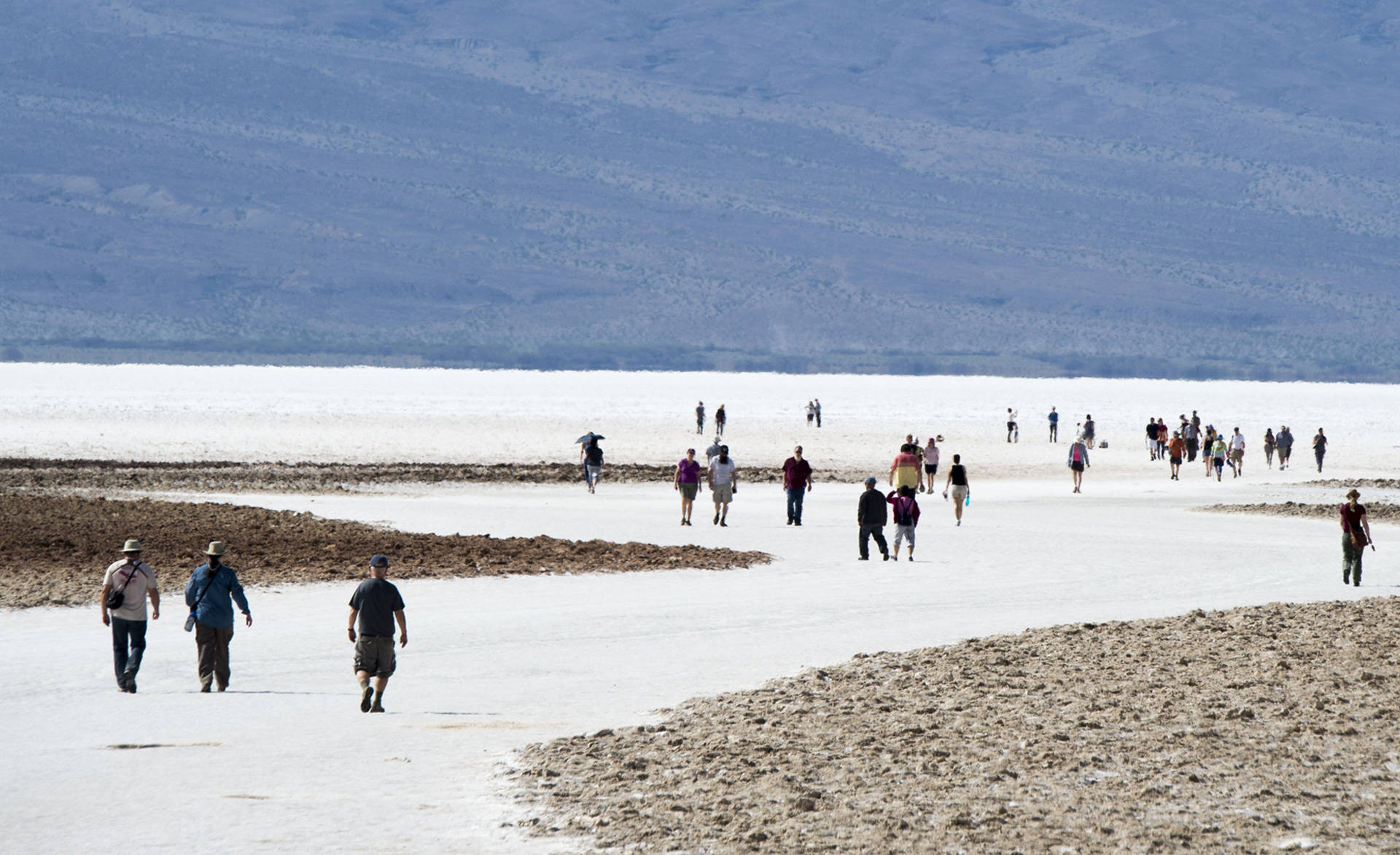
Extreme Heat Tourism? It's a Thing in Death Valley
Please try again
LAS VEGAS -- Desert dwellers in the western U.S. see temperatures topping 120 degrees (49 Celsius) as a reason to hunker down indoors and turn up the air conditioning.
But some tourists welcome it as a bucket-list opportunity to experience Death Valley -- famously the hottest place in America.
Many will get their chance in the days ahead as a vicious heatwave bakes parts of Arizona, California and Nevada.
The mercury at Death Valley National Park reached 124 degrees (51 Celsius) on Sunday, and temperatures are expected to keep climbing through midweek as a dry, high-pressure system lingers over much of the Southwest.
Many places saw triple-digit temperatures on Sunday, and the heatwave was blamed for power outages in several areas in California.
"There's very few places on Earth to go to experience those temperatures, and Death Valley is one of those," said John Adair, a National Weather Service meteorologist.
Business booms as temperatures soar in July and August at Panamint Springs Resort, near the entrance of Death Valley National Park.
"When it's 120 to 125 (degrees), there's more customers than there ever is," said Mike Orozco, who works at the resort that includes a restaurant, gas station, camp sites and cabins.
Orozco said locals jokingly refer to the summer spike as "European season," when a flood of tourists from Germany, France, Sweden and other places arrive in Death Valley to experience heat unheard of in Europe.
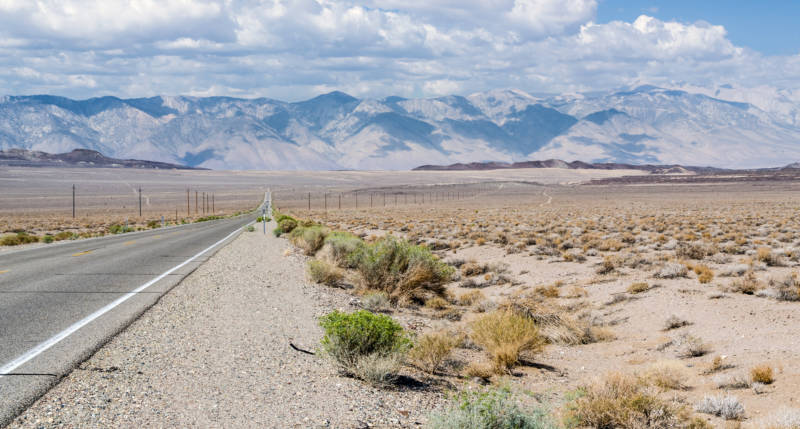
"Some people consider being out there in those conditions a kind of suffering. Other people can get a kind of euphoria, or a reward, out of it," said Ed Carreon, a commercial photographer in Los Angeles who regularly visits the park and prefers the scorching summer months.
"As a younger man, I would go out there to test myself" by hiking peaks in the Panamint Range under blazing sun in triple-digit temperatures with the barest of supplies, Carreon said.
Now 58, he recognizes those broiling excursions as the folly of youth. He still makes the treks but usually in the morning before the day heats up "and with the proper clothes, plenty of water and sunscreen."
Almost all of inland California was predicted to simmer at above normal temperatures. In Los Angeles County the airports in neighboring Palmdale and Lancaster each matched a record high of 108 degrees (42 Celsius) set in 1985.
Las Vegas temperatures topped at 110 degrees (43 Celsius) on Sunday and could reach 117 degrees (47 Celsius) when the heatwave peaks by midweek. That would be the highest temperature ever recorded at McCarran International Airport since logging began in 1937.
The National Weather Service in Phoenix said the last time the temperature topped 120 was 1995, at 121 degrees. It could happen again on Tuesday. The record high is 122 degrees, set on June 26, 1990.
Teresa Flores in Phoenix said she will make sure her two sons and daughter stay hydrated.
"Water, water, water, water," Flores said. "So even when they think they're not thirsty, they're drinking water."
To learn more about how we use your information, please read our privacy policy.
116 degrees at night: Death Valley’s extreme heat goes off the charts from climate change
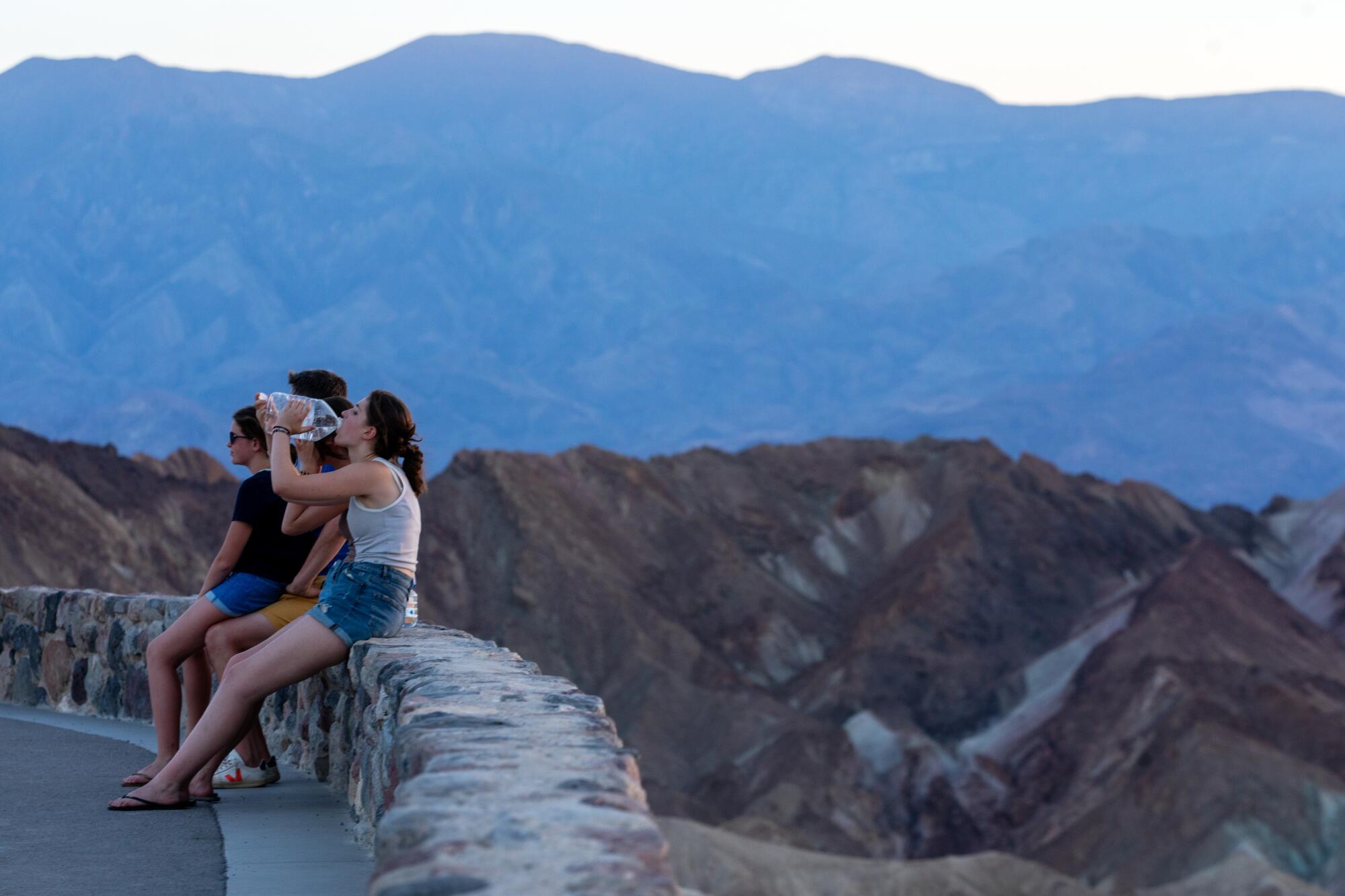
- Show more sharing options
- Copy Link URL Copied!
It was 10 p.m. and 116 degrees as a brutal wind whipped through the darkness.
Here in Death Valley National Park — dubbed the hottest place on Earth — intrepid tourists waded into a hotel swimming pool seeking what little relief they could find.
Park temperatures had soared to 126 degrees that afternoon, just a few degrees shy of the daily record.
“I never knew such temperatures before,” said Nicolas Combaret, 40, who was visiting Death Valley from France with his wife and 5-year-old son. It was one of several stops on their tour of the Southwest.
“When we saw on the news that the temperature would be 125, 126, we thought, ‘Wow, that’s impressive — it will be a good experience to live that, to feel the hottest ever here.’”
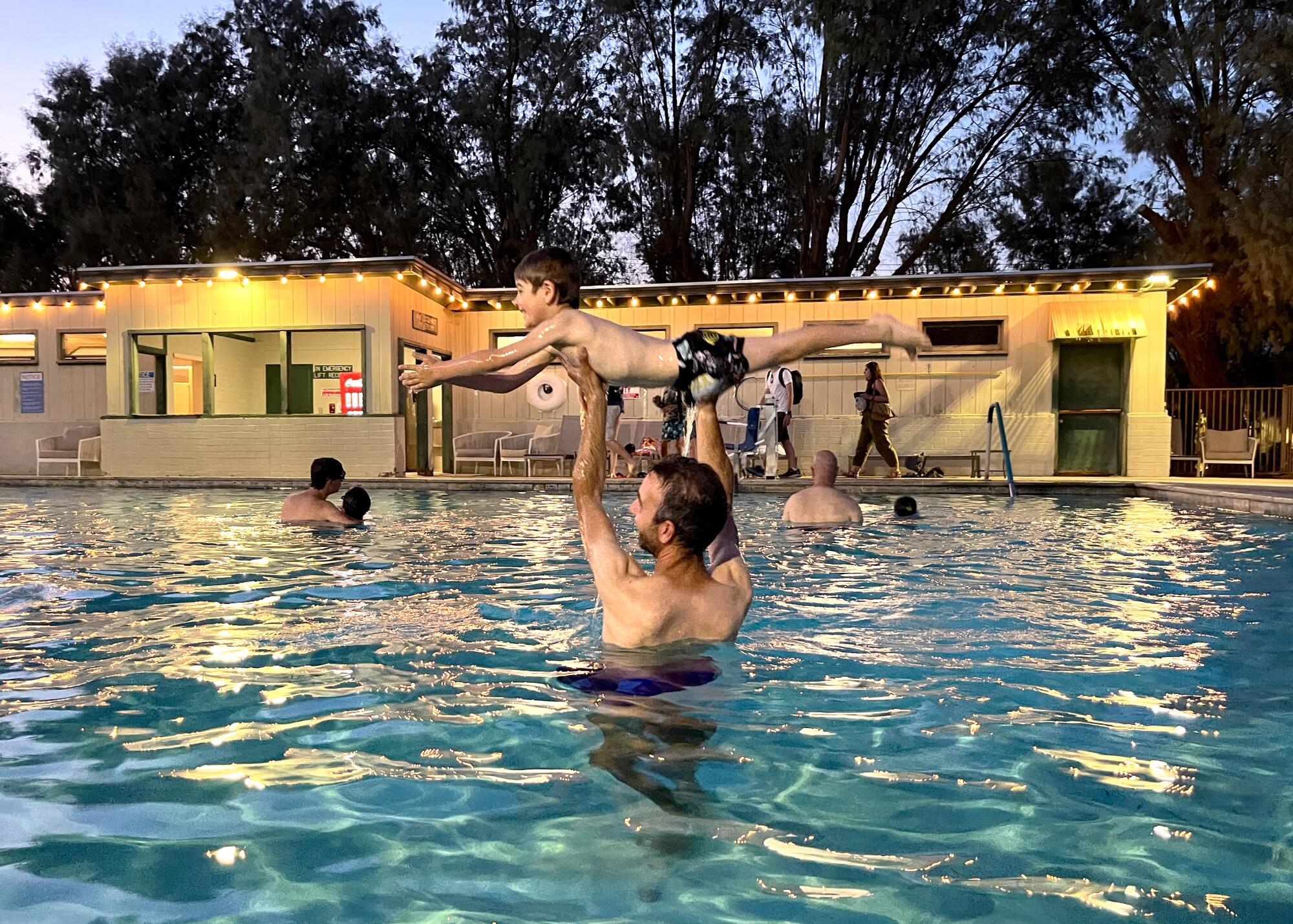
That the summertime heat can elicit comparisons to what life might feel like on the surface of the sun is nothing new.
Much of the reason for this is that Death Valley is a long, narrow basin that sinks 282 feet below sea level. The sun-bleached moonscape near the border of Nevada is hemmed in by jagged, rust-colored mountains, which trap hot air and circulate it like a convection oven.
But even Death Valley — one of the most extreme places on the planet — is not immune to climate change. This past week, many tuned in to see if its all-time temperature record of 134 degrees would be broken, a possibility that was heralded by some as a barometer of climate change.
Though the park fell short of that record, many who know Death Valley best say they’re already seeing the impacts of climate change on a near-daily basis.
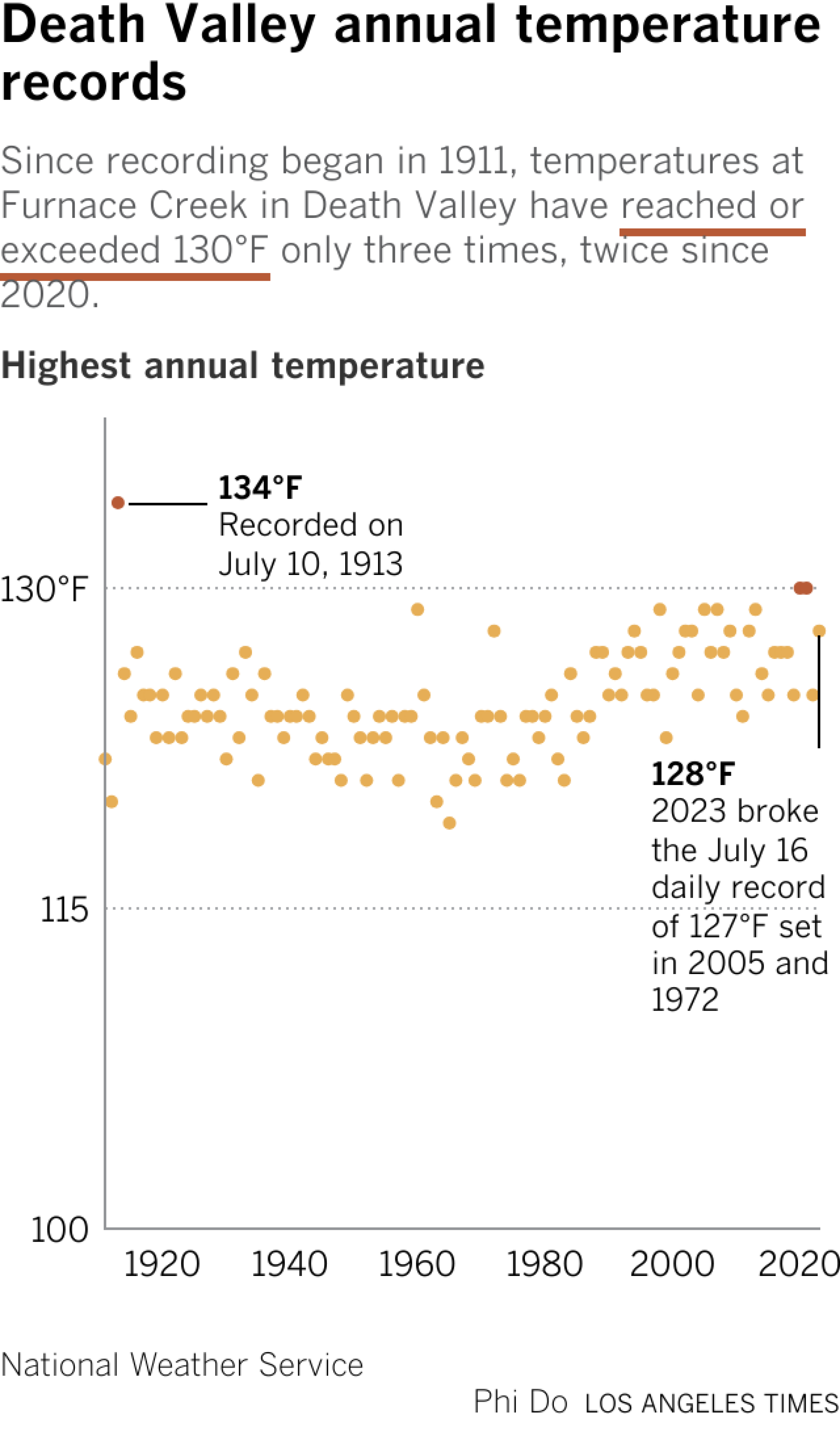
“As the climate changes, as world temperatures get hotter, Death Valley will get hotter,” said Giovanna Ponce, a public information officer with the park. She noted that seven of Death Valley’s hottest summers on record occurred in the past 10 years.
The hot days are also getting more frequent. The year 2020 holds the park’s record for the most days over 100 degrees — 169 days — according to data from the National Weather Service. The year 2021 broke the record for the most days over 125 degrees — 11.
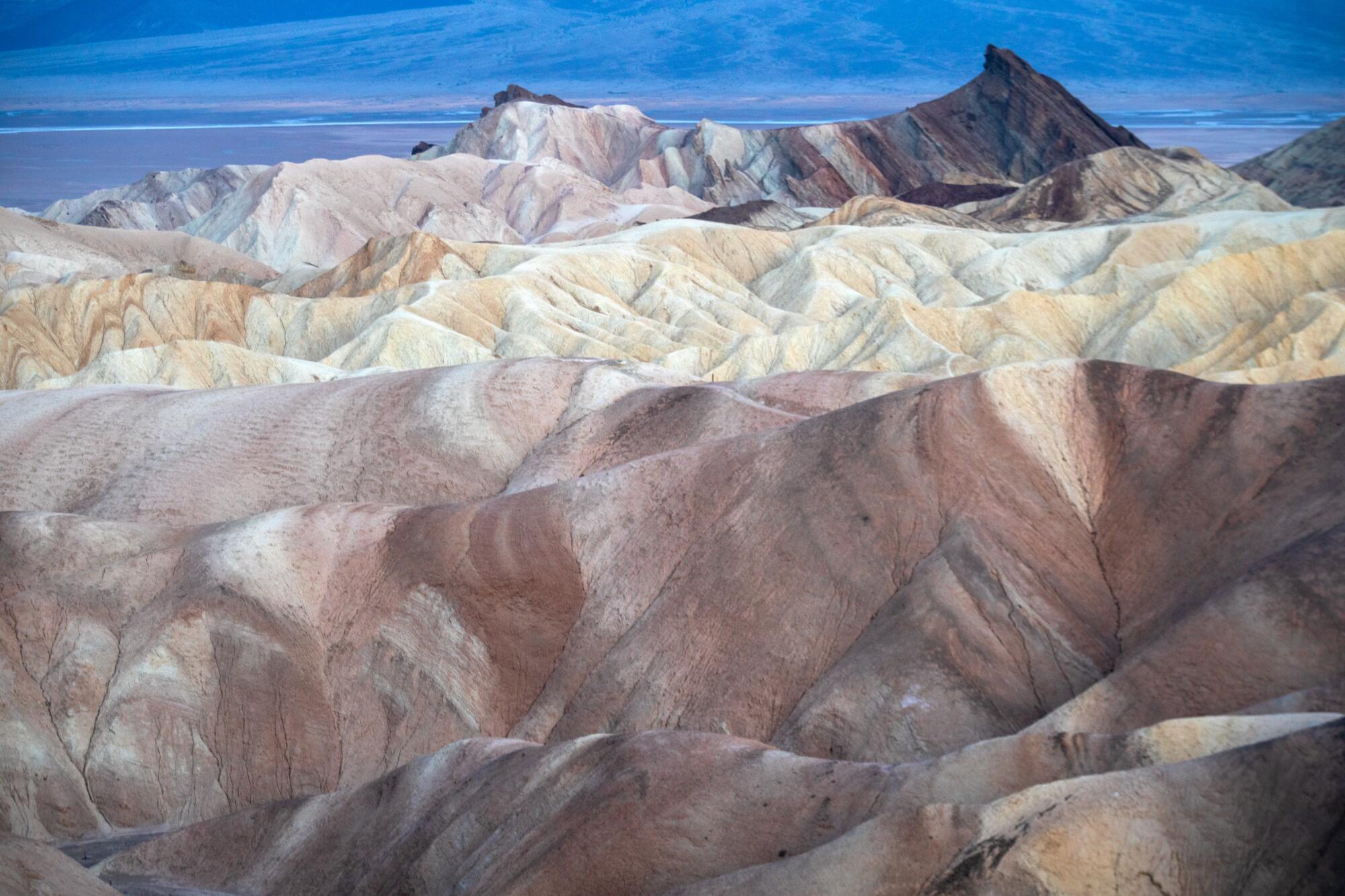
Tourists head to Death Valley to experience the scorching heat. (Video by Francine Orr).
If temperatures keep rising, there will be cascading impacts, including threats to birds, fish and ancient trees, officials said. Groundwater depletion and extreme precipitation are also accelerating, with last August seeing the rainiest day in Death Valley’s history, 1.7 inches, which triggered flash floods that scoured the landscape and damaged roads.
“Because the place is extreme, everything then is adapted and specialized for desert survival,” said Nichole Andler, a park ranger. “And when the extreme gets more extreme, it leads to struggle.”

Surviving Death Valley at 128 degrees ‘like a blow-dryer in my face’
Death Valley temperatures soared to 128 degrees Sunday, breaking the daily record of 127 degrees set in 2005 and 1972. It was expected to hit 125 on Monday.
July 17, 2023
In that way, the park has always been a place of extremes. But no place is immune to human-caused climate change, which is driving up global temperatures, warming oceans and shrinking ice sheets. This June was the Earth’s hottest June on record , according to the National Oceanic and Atmospheric Administration, and the next five years are expected to be the hottest ever recorded.
In Death Valley, one of the places feeling the change most acutely is Telescope Peak, the highest point in the park that is home to its population of ancient bristlecone pine trees . The trees’ mortality rate has increased about 70% in the last decade due to severe drought and bark beetle infestations, Ponce said.
“Those are some of the oldest trees on the planet, and previously thought to be very resistant,” she said.
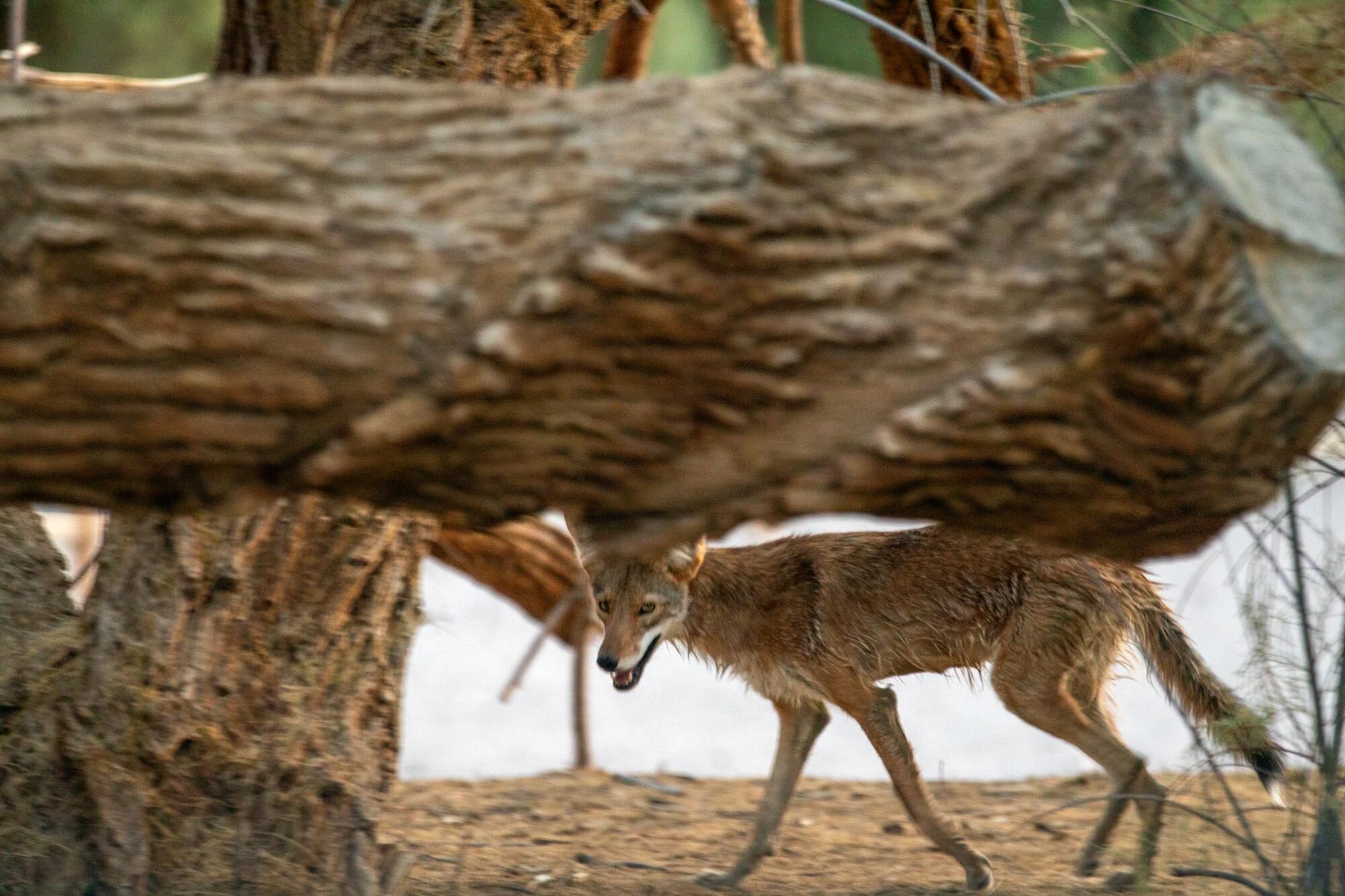
One 2022 study found that thousands of the trees have been killed at Telescope Peak since 2013, including some as old as 1,612 years. Their deaths indicate that even older bristlecone pines in the White Mountains, Great Basin National Park and elsewhere could be at risk, the study said.
Another study from 2019 found that about a third of Death Valley’s bird species have declined in the last 100 years due to heat stress associated with climate change; and yet another, from 2018 , concluded that the biggest declines of Mojave bird populations are occurring in Death Valley.
But the park’s scalding temperatures haven’t been enough to keep heat-seekers from trekking to the area to experience Mother Nature’s worst.
“It’s like hell,” said Robert Szulc, 51, who was leading a tour group from Poland up a hill to Zabriskie Point, a scenic overview. Szulc said he’s experienced extreme heat in the deserts of Africa, “but in the desert, you have hot days and cold nights, but here it’s different — the night here is hot.”
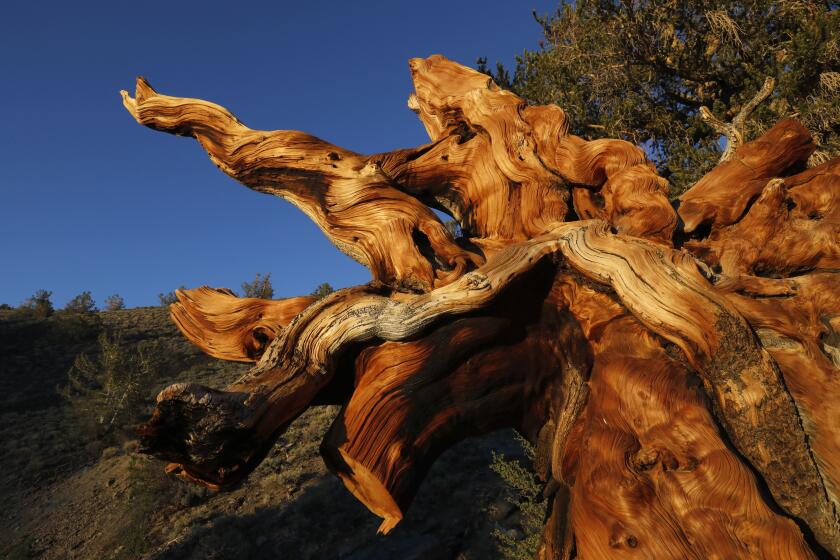
Climate & Environment
California drought, bark beetles killing the oldest trees on Earth. Can they be saved?
Extreme drought and bark beetles now threaten California’s Ancient Bristlecone Pine Forest, home to Methuselah, a 4,853-year-old bristlecone pine.
June 27, 2022
Evening temperatures in recent days have stayed over 100, offering little chance for relief. The low temperature on Sunday night was 103; and on Monday 101.
“It’s a dry heat,” said Steve Curry, 71, who was visiting Death Valley from the Sunland neighborhood of Los Angeles. No stranger to heat, Curry had hiked from Golden Canyon to Zabrieski Point early Tuesday morning and was scrunched into a tiny spot of shade beneath a metal interpretive sign.
“Everything is hot here,” he said, rapping on the metal.
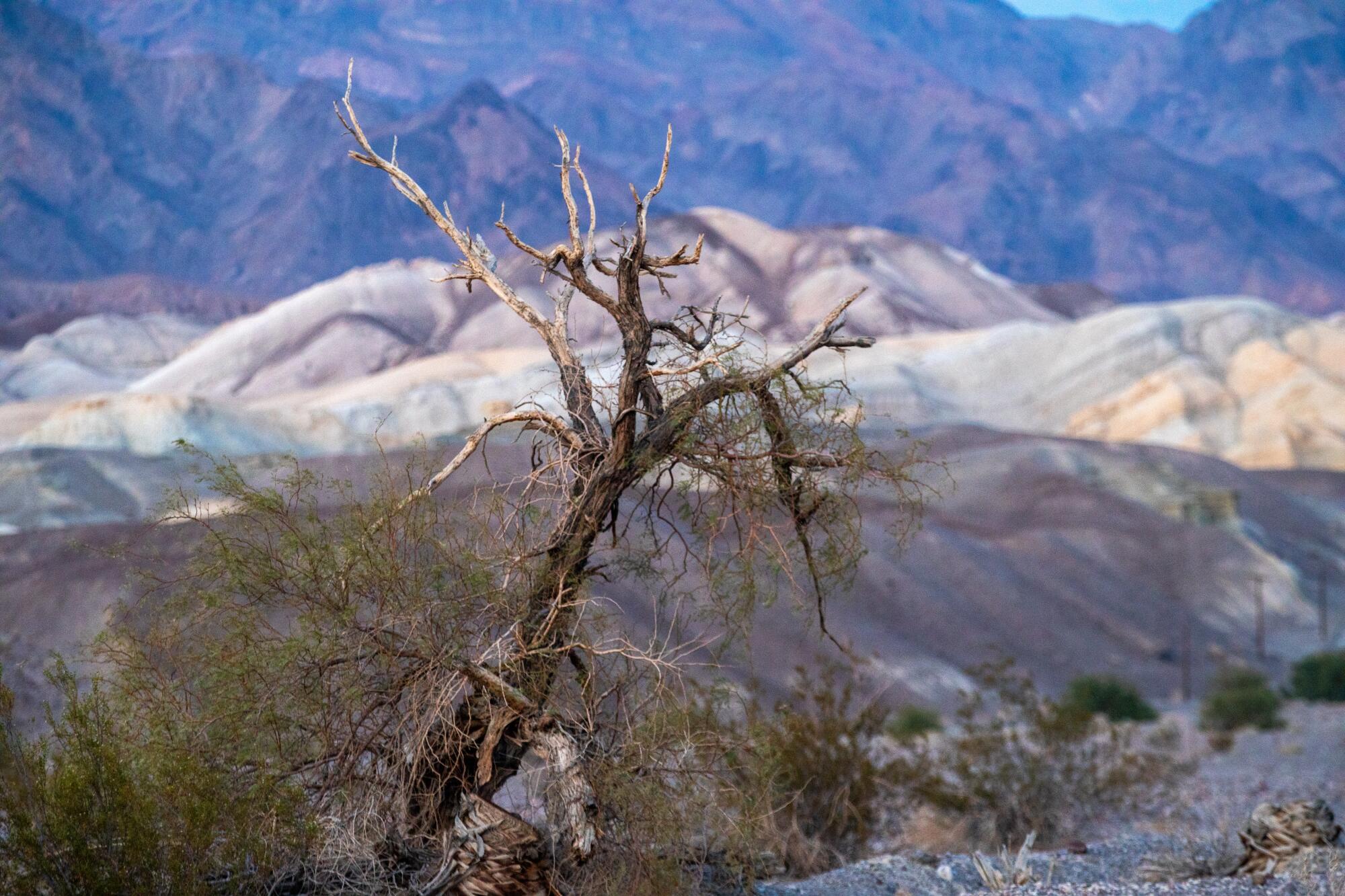
Such heat isn’t only affecting birds and trees and humans. The critically endangered Devils Hole pupfish can withstand the park’s very warm, very salty water, “but if it were to get any hotter, that could definitely impact their reproductive cycles and lead to a decrease in the population,” Ponce said.
The recent flash floods triggered by record rainfall also “confused” the fish, she added.
Death Valley, which typically receives less than 2 inches of rain per year, relies primarily on groundwater from natural springs to supply the smattering of hotels, golf courses and swimming pools designed for visitors.
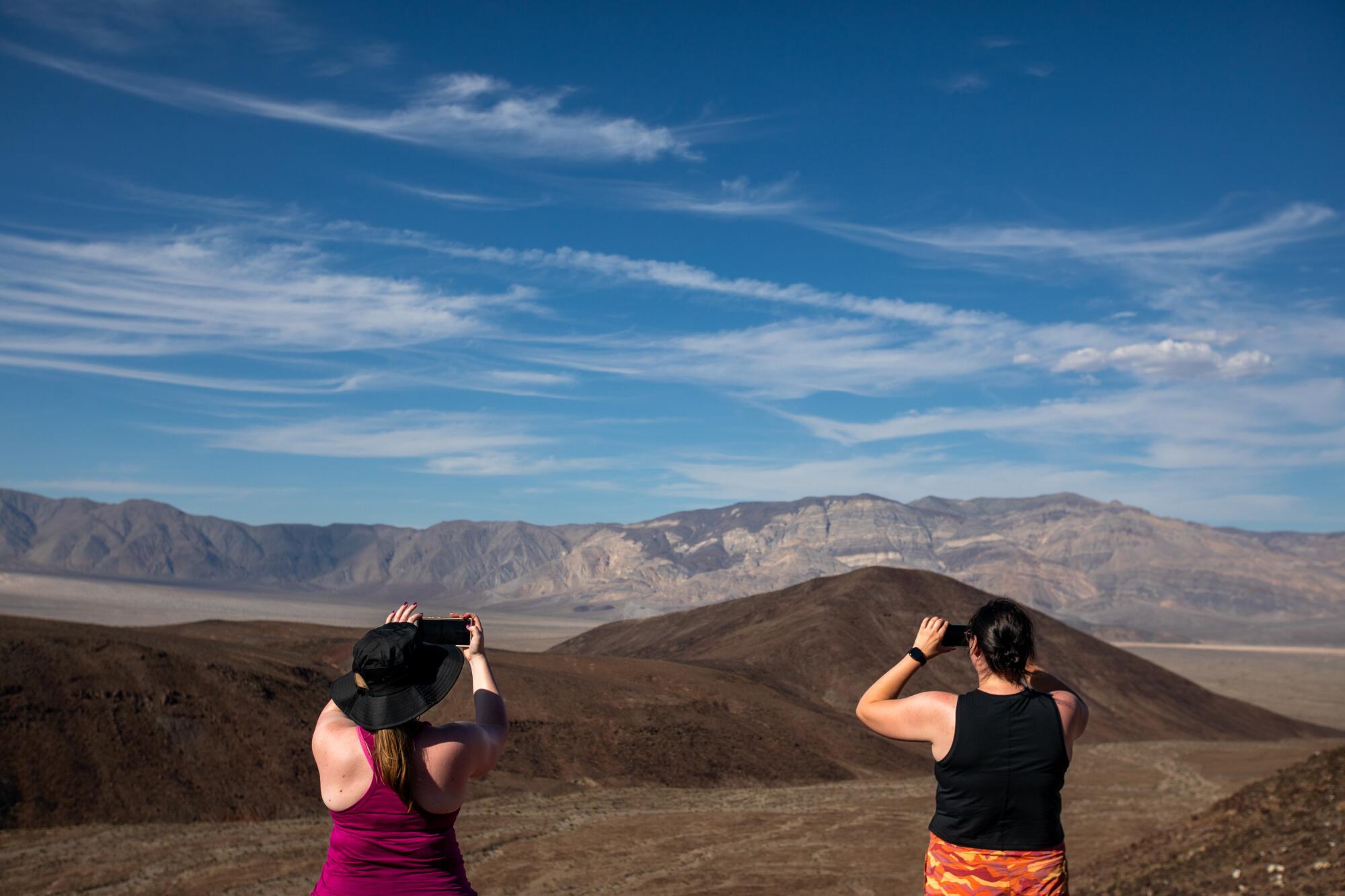
But even that supply has been threatened by worsening drought — particularly as development in surrounding areas leads to deeper wells and overpumping, park officials said.
Andler, the park ranger, noted that she tried to take advantage of a cooler spring this year to visit as many parts of the park as she could.
“I’d be like, ‘I’ve got to get there,’ because we may not have this much time to get to places later, because summers will probably be a little bit longer, and winters a little bit shorter,” she said.

Boiling Point: This heat is not normal
The climate crisis has arrived in the American West. Let’s meet it head on.
July 18, 2023
Some of Death Valley’s few longtime residents said those changes are beginning to feel more and more acute. One hotel worker, who asked not to be named because he was not authorized to speak with the press, said he’s lived here for about 10 years.
“The longer I’m here, the more this heat kicks my butt,” he said.
More to Read

Climate change supercharged a heat dome, intensifying 2021 fire season, study finds
April 22, 2024
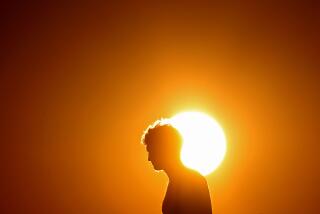

Editorial: If 10 straight months of record-breaking heat isn’t a climate emergency, what is?
April 17, 2024

After heavy storms, Death Valley is now open to kayakers: The return of ghostly Lake Manly
Feb. 21, 2024
Start your day right
Sign up for Essential California for news, features and recommendations from the L.A. Times and beyond in your inbox six days a week.
You may occasionally receive promotional content from the Los Angeles Times.

Hayley Smith is an environment reporter for the Los Angeles Times, where she covers the many ways climate change is reshaping life in California, including drought, floods, wildfires and deadly heat.

Francine Orr was a staff photojournalist for the Los Angeles Times from 2000-24. Previously, she was a staff photographer at the Kansas City Star. Orr served as a Peace Corps volunteer in Yap, Federated States of Micronesia. While there, she learned how to be a quiet observer and gained a love for stories. She was raised in Colorado and earned bachelor’s degrees in both history and art from the University of Saint Mary. In 2022, Orr received the coveted Dart Award for Excellence in Coverage of Trauma and the National Headliner Award. She also won the 2020 Meyer “Mike” Berger and was a Pulitzer Prize finalist in feature photography in 2012.
More From the Los Angeles Times
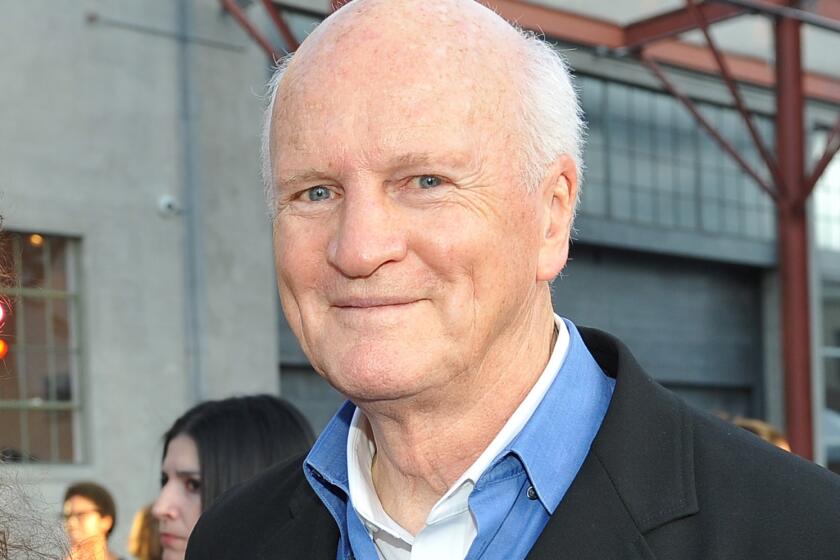
He was a leading art dealer. Now, the 80-year-old could face more than a decade in prison

In a battleground congressional district north of L.A., Trump verdict may be a wildcard in the November election
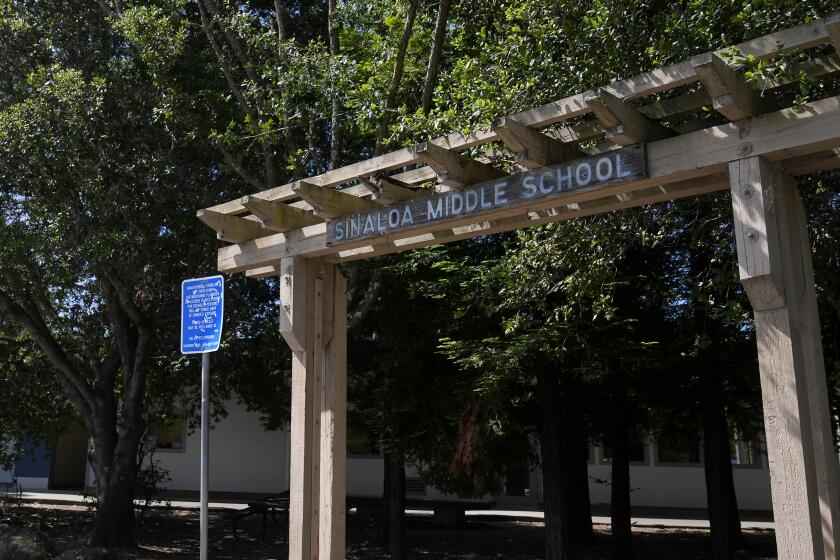
Eight girls arrested after Bay Area middle school brawl
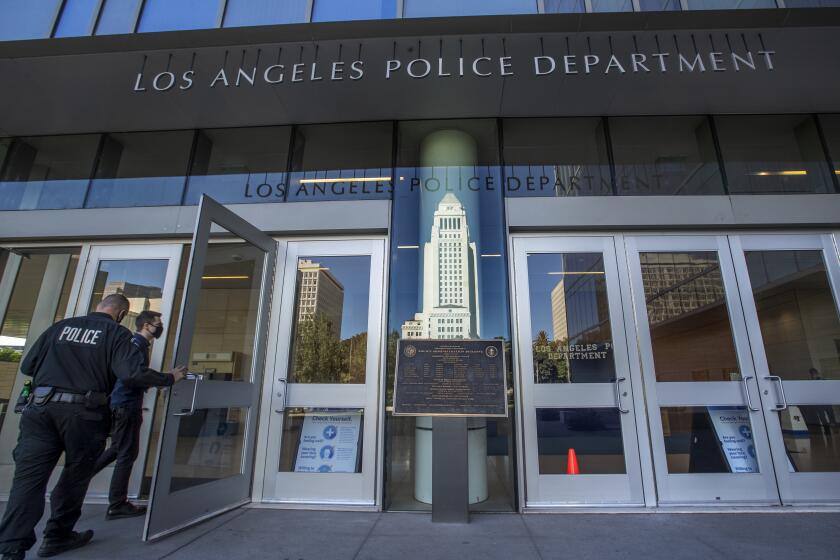
Off-duty LAPD officer shoots, kills unarmed man after altercation
- Skip to global NPS navigation
- Skip to this park navigation
- Skip to the main content
- Skip to this park information section
- Skip to the footer section

Exiting nps.gov
Alerts in effect, plan your visit.
Last updated: April 27, 2024
Park footer
Contact info, mailing address:.
P.O. Box 579 Death Valley, CA 92328
760 786-3200
Stay Connected
- Skip to main content
- Keyboard shortcuts for audio player
Summer 'Heat Tourists' Sweat With Smiles In Death Valley

Kirk Siegler

It's no secret that Death Valley, Calif., is one of the hottest, most unforgiving places on Earth come summertime. July 10 is the 100th anniversary of the hottest temperature ever recorded on the planet — 134 degrees Fahrenheit — and the heat is drawing tourists from all over the world to Death Valley.
Like Terminal 5 at London Heathrow Airport, Death Valley becomes a melting pot of foreign accents. On a recent afternoon, Belgian tourist Yan Klassens admires the view of the Badlands from Zabriskie Point, describing it as "nice, awesome and colorful."
But the 122 degree heat?
"Oh! Warm. Too hot! Very warm," the tourists say. "We like it!"

Jonathan Rice, dressed as Darth Vader, gulps down a bottle of Vitamin Water after running a 6:36 mile in the hottest stretch of Death Valley. Rice has been doing the run to try and set a world record for the fastest mile run in a record-setting temperature and has dubbed it the "Darth Valley Challenge." David Gilkey/NPR hide caption
Jonathan Rice, dressed as Darth Vader, gulps down a bottle of Vitamin Water after running a 6:36 mile in the hottest stretch of Death Valley. Rice has been doing the run to try and set a world record for the fastest mile run in a record-setting temperature and has dubbed it the "Darth Valley Challenge."
Klassen and his friends Yulka Derlay and Frieda Van Campenhotte are visiting from Belgium. Voluntarily.
"Always a wall of heat," Klassen says. "When you get out of a room or a building or a bus, with air co, and you get out, the wall of heat. Boof!"
It turns out these Belgians are among a throng of international tourists who come here in the dead of summer to experience this heat. In fact, July is now Death Valley National Park's busiest month. And you can't turn around without seeing Germans, Chinese or Kiwis. The term for this type of traveling is called "heat tourism."
Park ranger Charlie Callagan clutches two big water bottles. A wide brimmed hat shelters his face from the sun, but he's still drenched in sweat. He finds the idea behind "heat tourism" a little puzzling, but he's going with it. These tourists come to experience temperatures they can't back home, Callagan says, and won't stay for an extended period of time.
"It's one of the few places in the world where you can easily come out and experience temperatures into the 120s," he says, "and that's why we get visitors from all over the world."
Later in the afternoon, the mercury nears 129. A crowd gathers around a digital sign displaying the temperature outside the Furnace Creek Visitor Center. People are taking their pictures next to the sign.
But some of these tourists didn't come just for Death Valley. Some, like Richard Johansen of Sweden, are just passing through after a few days at Yosemite National Park.
"We were going to Las Vegas," he says. "We thought we could take the road through Death Valley." Before this trip, Johansen and his friends never felt anything hotter than 95 degrees.
The area feels and kind of smells like a sauna. A couple of mesquite trees behind the thermometer seem to be smoldering in the heat. It's all kind of a spectacle. Those sorry-looking trees and a sea of white socks, sandals and pale skin shine in the desert sun.

The Two-Way
Want to be in the dark death valley is among 20 recommended places.

Will Death Valley Top 130 Degrees? Here's Where To Watch
Around the nation, park service cleans up eggs in death valley.
And then there's the guy in a Darth Vader costume. John Rice, the man behind the mask, is helping uphold Death Valley's reputation as a magnet for the eccentric.
"Well, I am attempting to set a world record for the hottest verified mile ever run by a human being," he says. "And I decided that wasn't tough enough, so I would do it in a Darth Vader costume, to just, you know, add to the spice."
Rice, who is from England and lives in Colorado, calls this mile the "Darth Valley challenge." Several scenes from Star Wars were filmed just down the road. Rice returns from his run down the Tatooine Desert in less than seven minutes.
Breathing heavily, Rice says the run was a little tough. "I probably went out a little fast, and then when my mask kept falling off, it slowed me down quite a bit." He adds that he trained extensively for this for more than a year, in a sauna.
Whether it's world record material, that's not clear yet. But the dedication is impressive.
Knowledge is power
Stay in the know about climate impacts and solutions. Subscribe to our newsletters.
- Eye on the Storm News
- Weekly News from Yale Climate Connections
Stay in the know about climate impacts and solutions. Subscribe to our weekly newsletter.
By clicking submit, you agree to share your email address with the site owner and Mailchimp to receive emails from the site owner. Use the unsubscribe link in those emails to opt out at any time.

Yale Climate Connections
Death Valley, California, breaks the all-time world heat record for the second year in a row

Share this:
- Click to share on Facebook (Opens in new window)
- Click to share on X (Opens in new window)

For the second consecutive year, Death Valley, California, has set a world record for the hottest reliably measured temperature in Earth’s history.
Death Valley National Park’s Furnace Creek Visitor Center hit an astonishing 130.0 degrees Fahrenheit (54.4°C) on Friday afternoon, July 9, 2021, beating the previous world record of 129.9 degrees Fahrenheit (54.4°C), set there on August 16, 2020. For perspective, according to What’s Cooking America , a medium-rare steak is cooked to an internal temperature of 130-135°F.
According to weather records expert Christopher Burt, who wrote the comprehensive weather records book Extreme Weather , and extreme weather expert Maximiliano Herrera, who tweets under the Twitter handle Extreme Temperatures Around the World , the observation, if confirmed, would be the hottest reliably recorded temperature in world history.
Cautions about the record
Friday’s measurement will have to undergo review by the World Meteorological Organization (WMO) before being declared officially valid. Two possible areas of concern are that the temperatures at Furnace Creek showed a steep jump during the afternoon, and the nearby Stovepipe Wells station was considerably cooler, topping out at 122.6 degrees Fahrenheit (50.3°C). (See the raw high-resolution Furnace Creek data here by choosing a time up to six days in the past from the drop-down menu, then choosing “Decoded Data”.) WMO has not yet certified last year’s 129.9 degrees Fahrenheit (54.4°C) reading on August 16, 2020 at Furnace Creek as valid, so there may be a long wait. Fortunately, we’ll have excellent independent verification of this year’s measurement thanks to a temporary thermometer set up at the site in May by Campbell Scientific.
Climatologist William Reid, an expert on Death Valley meteorology who has written extensively about the site, cautioned that an increase in vegetation and structures built in the vicinity of the Furnace Creek site in recent decades has allowed the station to record hotter temperatures.
“An increase in vegetation and some man-made structures not too far south of the station have resulted in poorer ventilation through the station area. Since the station is above a bare and sandy surface, hot air along the ground during afternoon sunshine is less effectively mixed away from the instrumentation. The result is higher temperature readings during the afternoon comparably,” Reid wrote. “I figure that most summer maximums at Death Valley today are a couple of degrees higher because of the poorer station exposure. A day that hits 125 degrees today probably would have only been as high as 122-123 degrees before 1980.”
Official world record remains 134°F at Furnace Creek in 1913
“If Friday’s observation passes an investigation (instrument calibration, etc.) then, yes, this is a new reliably measured global extreme heat record,” Burt wrote by email.
But the observation will not count as an official world record. In 2013, WMO officially decertified the official all-time hottest temperature in world history, a 136.4 degrees Fahrenheit (58.0°C) reading from Al Azizia, Libya, in 1923. (Burt was a member of the WMO team that made the determination.) With the Libya record abandoned, the official world record was given to a 134 degrees Fahrenheit (56.7°C) measurement taken at Death Valley on July 10, 1913.
However, this record has been strongly disputed by Burt, Herrera, and Reid.
“The old Death Valley record from July 1913 is 100% bogus (not just 99.9% such), as are all other temperature readings of 130 degrees Fahrenheit or higher from Africa in the past,” Burt said.
Burt wrote a detailed 2016 blog post at Weather Underground challenging the 1913 record at Death Valley, explaining that official readings of 134, 130, and 131 degrees Fahrenheit taken on July 10, 12, and 13, 1913 were likely the result of an inexperienced observer. Climatologist William Reid has also extensively researched what he calls an “improbable record” in 1913. In order for the 1913 Death Valley record to be decertified, though, an official WMO investigation committee would have to be assembled to look into the matter, a years-long process for which there is currently no motivation.
The only other temperature of at least 130 degrees Fahrenheit officially recognized by WMO is a 131-degree reading at Kebili, Tunisia, set July 7, 1931, which is considered to be Africa’s hottest temperature.
Burt disputed this record: “I mentioned to the WMO about the Kebili temperature of 131 degrees Fahrenheit back in 2012, when asked what I thought the next hottest temperature in Africa (after Al Azzia) might be, since that was the only temperature over 130 degrees Fahrenheit that had an actual date attached to it. However, the Kebili ‘record’ is even more bogus than even the Al Azzia record, and I said so. Kebili is a relatively cool spot in Tunisia (an oasis) and never since the 1930s ever again recorded a maximum temperature above 118 degrees Fahrenheit. Nowhere in Africa has any reliably observed temperature been measured above 126 degrees Fahrenheit.”

Top-10 list of hottest world temperatures: Furnace Creek dominates
Furnace Creek made a run at beating its Friday world record on Saturday, but according to an email from climatologist William Reid, who visited Death Valley that day, high clouds moved over the station in the afternoon, allowing the temperature to reach “only” 129.4 degrees Fahrenheit (54.1°C). Even so, the highs Friday and Saturday mean that the planet’s top three hottest reliably measured temperatures on record have all occurred at Furnace Creek in the past year. Here’s is Earth’s top-ten list of hottest reliably measured temperatures:
1) 54.4° C (130.0°F), 7/09/2021, Furnace Creek (California, U.S.); 2) 54.4° C (129.9°F), 8/16/2020, Furnace Creek (California, U.S.); 3) 54.1° C (129.4°F), 7/10/2021, Furnace Creek (California, U.S.); 4) 54.0° C (129.2°F), 6/30/2013, Furnace Creek (California, U.S.); 4) 54.0° C (129.2°F), 7/21/2016, Mitribah (Kuwait); 6) 53.9° C (129.0°F), 7/17/1998, Furnace Creek (California, U.S.); 6) 53.9° C (129.0°F), 7/19/2005, Furnace Creek (California, U.S.); 6) 53.9° C (129.0°F), 7/06/2007, Furnace Creek (California, U.S.); 6) 53.9° C (129.0°F), 7/22/2016, Basra International Airport (Iraq); and 10) 53.8° C (128.8°F), 7/22/2016, Basra-Hussen (Iraq).
Kudos go to Maximiliano Herrera (@extremetemps ) and Jérôme Reynaud ( geoclimat.org ) for helping assemble this list.

Highest recorded minimum temperature in North America: 107.7°F
Another astonishing heat record occurred on Sunday, when the 24-hour low temperature at Stovepipe Wells , also located in Death Valley, dropped to a ridiculously hot 107.7 degrees Fahrenheit (42.1°C). The previous North American hottest reliably measured minimum temperature on record was 107 degrees Fahrenheit (41.7°C) at Furnace Creek on July 12, 2012. On Sunday, the high temperature at Stovepipe Wells hit 128.6 degrees Fahrenheit (53.7°C) – one of the hottest U.S. temperatures ever measured. Summing together Sunday’s high and low and dividing by two gives an average temperature for the day of 118.1 degrees Fahrenheit (47.8°C), which is very likely a world record for reliably measured average daily temperature.
According to weather records expert Maximiliano Herrera (@extremetemps ), only one location worldwide has recorded a higher overnight minimum temperature than Stovepipe Wells: Oman. The world record for highest 24-hour minimum temperature is 108.7 degrees Fahrenheit (42.6°C) at Qurayyat, Oman, on June 26, 2018. The world record for highest overnight low (12-hour low) is 111.6 degrees Fahrenheit (44.2°C) at Khasab Airport, Oman, on June 17, 2017.
Note that the Western Region Climate Center shows seven daily minimums of 110°F occurred at Death Valley’s Greenland Ranch, primarily in the 1920s. These would be the official hottest minimums on record for the world, presumably. However, in an email, climatologist William Reid said, “Do I believe they are authentic? No. The record provided by the observer is plagued by some of the problems found during the 1913 era at the site”.
Stovepipe Wells, established in 2004, is part of NOAA’s Climate Reference Network, with equipment among the highest quality in the world. The station is located at an elevation of 80 feet (24 m), and is usually 3-5 degrees Fahrenheit cooler than Furnace Creek, which is at -193 feet (-59 m).
Other all-time heat records July 9-11
Among U.S. stations with long periods of record spanning at least 40 years, there were at least 12 sites that tied or exceeded their previous all-time (any day) heat record during the July 9-11 western U.S. heat wave (kudos to Maximiliano Herrera for this list):
July 9: Grand Junction, CO: 107°F (41.7°C), new record Tonopah, NV: 104°F (40.0°C), tied
July 10: St. George, UT: 117°F (47.2°C), ties all-time state record for Utah Farmington, NM: 106°F (41.1°C), new record St. Johns, AZ: 104°F (40.0°C), tied Page, AZ: 111°F (43.9°C), tied Mercury, NV: 113°F (45.0°C), tied Toponah, NV: 104°F (40.0°C), tied Las Vegas Airport, NV: 117°F (47.2°C), tied China Lake, CA: 119°F (48.3°C), tied Barstow-Daggett Airport, CA: 118°F (47.8°C), tied Bishop, CA: 111°F (43.9°C), new record Winslow, AZ: 110°F (43.3°C), new record
July 11: Tonopah, NV: 105°F (40.6°C), new record
This list may be updated if additional records come to light, or are set on Monday, when the heat wave will be winding down. Over the past 30 days, according to the NOAA/NCEI database of record highs and lows, the U.S. has racked up a startling total of at least 301 all-time record highs. NOAA’s list includes stations with a period of record shorter than 40 years, though.
Update from July 13: Many more all-time heat records fell July 9-11 in Utah, Arizona, California, Colorado, and Nevada, according to Maximiliano Herrera. In Utah alone, there were these: Eskdale (tied), Kodachrome Basin (tied), Fort Duchesne (tied), Hovenweep 109°F on July 9 (beaten), Escalante 106°F on July 9 (beaten), and Bullfrog Basin 114°F on July 10 (beaten).

Déjà vu : another extreme high-pressure ridge predicted for the western U.S. next week
It’s July, the hottest month of the year in the Northern Hemisphere, and extreme ridges of high pressure forming in July have a good chance of setting all-time heat records. Unfortunately, the latest long-range forecasts from the GFS and European models predict that the western U.S. will have another unusually intense ridge of high pressure capable of overthrowing more all-time U.S. heat records next week.
By one common measure, the 0Z Monday run of the European model is predicting that the heat dome at the center of this upper-level high will be nearly as strong as any ever observed in the region. Warm air expanding at lower levels pushes the height of the 500-millibar surface, roughly at the midpoint of the atmosphere, upward. The model predicted a 500-mb height of 599 decameters over Wyoming on July 20. The record-high 500-millibar height at Riverton, Wyoming, as measured in twice-daily weather-balloon launches (soundings) since 1948, is 605 dm.
But long-range forecasts of this nature are often inaccurate, so the coming heat wave may fall short of setting all-time records. However, the models did an excellent job seven days in advance in predicting the intensity of this past weekend’s extreme ridge of high pressure. Even if the next heat wave falls short of setting all-time records, it will boost the odds of significant wildfire activity, and intensify the record drought gripping the western U.S., where severe to exceptional drought (levels D2 to D4) was at 83% last week – the highest level since the U.S. Drought Monitor was established in 2000.
The Bootleg fire in Oregon is burning out of control as the West endures its third heat wave this summer. The blaze has scorched more than 143,000 acres, threatening a major power grid. https://t.co/9iAwvLrxWY — The New York Times (@nytimes) July 12, 2021
Kudos to Maximiliano Herrera (@extremetemps ), William Reid ( stormbruiser.com ), Jérôme Reynaud ( geoclimat.org ), Chris Burt, Bob Henson (@bhensonweather ), Howard Rainford, Etienne Kapikian ( @EKMEteo ), and Thierry Goose (@ThierryGooseBC ), for their assistance on this post.
Website visitors can comment on “Eye on the Storm” posts . Please read our Comments Policy prior to posting. Comments are generally open for 30 days from date posted. Sign up to receive email announcements of new postings here . Twitter: @DrJeffMasters and @bhensonweather
Jeff Masters
Jeff Masters, Ph.D., worked as a hurricane scientist with the NOAA Hurricane Hunters from 1986-1990. After a near-fatal flight into category 5 Hurricane Hugo, he left the Hurricane Hunters to pursue a... More by Jeff Masters
Watch CBS News
Death Valley, hottest place on Earth, hits near-record high as blistering heat wave continues
Updated on: July 17, 2023 / 7:40 PM EDT / CBS/AP
Death Valley, Calif. — Long the hottest place on Earth, Death Valley put a sizzling exclamation point Sunday on a record warm summer that's baking nearly the entire globe by flirting with some of the hottest temperatures ever recorded, meteorologists said.
In Buckeye, Ariz., the heat apparently claimed a life Sunday. Police there say an elderly man was found dead in the desert after going for a bike ride. He had to walk when the bike got a flat tire, his wife told authorities. His death appeared heat-related, police said, but the medical examiner was going to determine what killed him.
Some 83 million people in the U.S. were under heat warnings or advisories Monday, CBS News weather producer David Parkinson said. "The nexus of record heat has shifted just a bit east (from California) to Arizona, New Mexico and Texas," he said.
Parkinson predicts 20 heat-related records will be set Monday in six states with the same number of records and states setting new marks Turesday.
Temperatures in Death Valley, which runs along part of central California's border with Nevada, reached 125.6 degrees Fahrenheit Sunday at the aptly named Furnace Creek, the National Weather Service said .
The hottest temperature ever recorded on Earth was 134 degrees in July 1913 at Furnace Creek, said Randy Ceverny of the World Meteorological Organization, the body recognized as keeper of world records. Temperatures at or above 130 degrees have only been recorded on Earth a handful of times, mostly in Death Valley.
"With global warming , such temperatures are becoming more and more likely to occur," Ceverny, the World Meteorological Organization's records coordinator, said in an email. "Long-term: Global warming is causing higher and more frequent temperature extremes. Short-term: This particular weekend is being driven by a very very strong upper-level ridge of high pressure over the Western U.S."
Furnace Creek is an unincorporated community within Death Valley National Park. It's home to the park's visitor center, which includes a digital thermometer popular with tourists. On Sunday afternoon, dozens of people gathered at the thermometer - some wearing fur coats as a joke - hoping to snap a picture with a temperature reading that would shock their friends and family.
That reading, though unofficial reached 130 degrees.

A few miles away at Badwater Basin - the lowest point in North America at 282 feet below sea level - tourists took selfies and briefly walked along the white salt flats ringed by sandy-colored mountains as wisps of clouds crawled overhead. Meteorologists say thin cloud cover most likely kept temperatures from reaching potential record highs.

William Cadwallader lives in Las Vegas, where temperatures reached 116 degrees on Sunday, nearing the all-time high of 117 degrees. But Cadwallader said he's been visiting Death Valley during the summer for years just to say he's been to the hottest place on Earth.
"I just want to go to a place, sort of like Mount Everest, to say, you know, you did it," he said.
The heat wave is just one part of the extreme weather hitting the U.S. over the weekend. Five people died in Pennsylvania on Saturday when heavy rains caused a sudden flash flood that swept away multiple cars. A 9-month-old boy and a 2-year-old girl remained missing.
In Vermont, authorities were concerned about landslides as rain continued after days of flooding. CBS Burlington affiliate WCAX-TV reported that a home was destroyed and other evacuations took place after a landslide Friday night.
Death Valley's brutal temperatures come amid a blistering stretch of hot weather that's put roughly one-third of Americans under some type of heat advisory, watch or warning. Heat waves aren't as visually dramatic as other natural disasters, but experts say they're more deadly. A heat wave in parts of the South and Midwest killed more than a dozen people last month.

The National Weather Service's Weather Prediction Center says the heat wave will continue in the Southwest, South Central U.S. and South Florida.
Residents in the Western U.S. have long been accustomed to extreme temperatures, and the heat appeared to prompt minimal disruptions in California over the weekend. Local governments opened cooling centers for people without access to air conditioning to stay cool. The heat forced officials to cancel horse racing at the opening weekend of the California State Fair as officials urged fair-goers to stay hydrated and seek refuge inside one of the seven air-conditioned buildings.
And in the San Francisco vicinity, the heat knocked out National Weather Service radar on Mount Umunhum, CBS New Bay Area reports .
Temperatures in Phoenix hit 114 degrees Sunday, the 17th consecutive day of 110 degrees or higher. The record is 18 days, set in June 1974. Phoenix is on track to break that record on Tuesday, said Gabriel Lojero, a meteorologist with the National Weather Service.
But CBS Phoenix affiliate KPHO-TV reports that the city only has one 24/7 cooling center for the public to access .
Heat records are being shattered all over the U.S. South, from California to Florida. But it's far more than that. It's worldwide, with devastating heat hitting Europe along with dramatic floods in the U.S. Northeast, India, Japan and China.
The Miami Herald points out that the National Weather Service issued its first Excessive Heat Warning for Miami-Dade County Sunday after relaxing the rules for issuing such warnings and advisories for the region to one in which the heat index - what the heat and humidity combined feel like - stay at 110 degrees or higher for at least two hours. It's been extended until 7 p.m. Tuesday .
For nearly all of July, the world has been in uncharted hot territory, according to the University of Maine's Climate Reanalyzer.
June was also the hottest June on record, according to several weather agencies. Scientists say there is a decent chance that 2023 will go down as the hottest year on record, with measurements going back to the middle of the 19th century.
Death Valley dominates global heat records. In the valley, it's not only hot, it stays brutally warm.
Some meteorologists have disputed how accurate Death Valley's 110-year-old hot-temperature record is, with weather historian Christopher Burt disputing it for several reasons, which he laid out in a blog post a few years ago.
The two hottest temperatures on record are the 134 degrees 1913 in Death Valley and 131 in Tunisia in July 1931. Burt, a weather historian for The Weather Company, finds fault with both of those measurements and lists 130 in July 2021 in Death Valley as his hottest recorded temperature on Earth.
"130 degrees is very rare if not unique," Burt said.
In July 2021 and August 2020, Death Valley recorded a reading of 130 degrees, but both are still awaiting confirmation. Scientists have found no problems so far, but they haven't finished the analysis, NOAA climate analysis chief Russ Vose said.
There are other places similar to Death Valley that may be as hot, such as Iran's Lut Desert, but like Death Valley are uninhabited so no one measures there, Burt said. The difference was someone decided to put an official weather station in Death Valley in 1911, he said.
A combination of long-term human-caused climate change from the burning of coal, oil and natural gas is making the world hotter by the decade, with ups and downs year by year. Many of those ups and downs are caused by the natural El Nino and La Nina cycle. An El Nino cycle, the warming of part of the Pacific that changes the world's weather, adds even more heat to the already rising temperatures.
Scientists such as Vose say that most of the record warming the Earth is now seeing is from human-caused climate change, partly because this El Nino only started a few months ago and is still weak to moderate. It isn't expected to peak until winter, so scientists predict next year will be even hotter than this year.
More from CBS News

81-year-old "serial slingshot shooter" found dead days after arrest

Judge to mull overturning Polly Klaas killer's death sentence
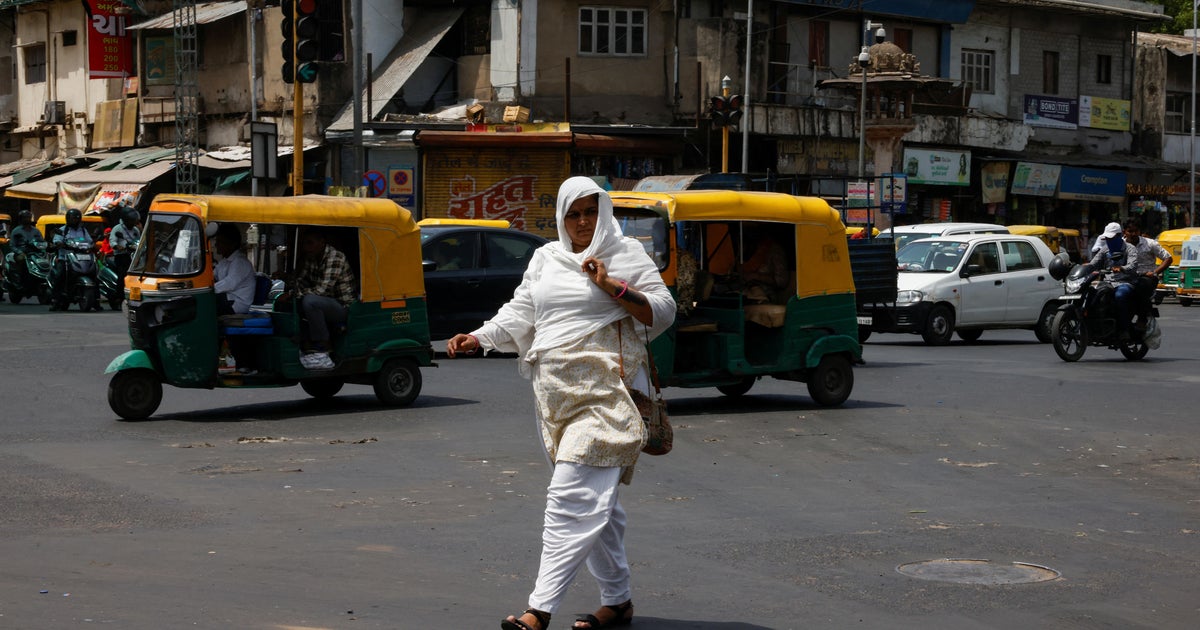
Delhi temperature may break record for India's highest: 126.1 degrees

40 years after dead baby found, Vermont police find the parents

Notorious California park expected to see cruelly hot weather soon
C alifornia’s notoriously sun-scorched Death Valley National Park is about to see even hotter weather than usual, meteorologists warned.
Starting Friday, temperatures at Furnace Creek are forecast to reach around 111 degrees and climb as high as 117 degrees by Wednesday of next week. That translates to a “major” heat risk category for the Death Valley area, Jenn Varian, a meteorologist with the Nevada National Weather Service, office told SFGATE. Visitors who aren’t able to stay cool or hydrated will be at higher risk of heat stroke and exhaustion, she said.
Overall, by the end of next week, temperatures are expected to be 10 degrees above average for the region, Varian said.
Aside from personal safety, there are external hazards to be aware of. “Sometimes vehicles are just not equipped to handle that kind of heat,” Varian said, adding that she’s “noticing an increased frequency of cars breaking down.” Though it may be tempting to leave the road and seek out shade or someone who could help if a car breaks down, travelers are encouraged to stay with their vehicles on the road because other drivers are more likely to pass by and see them on the thoroughfares.
Last year, a hiker died in Death Valley amid 121-degree heat hours after being profiled by the LA Times, SFGATE previously reported .
According to the National Weather Service website , anyone exposed to dangerous levels of heat should hydrate, take plenty of breaks in the shade, and check on at-risk individuals like older people. Children and pets should never be left in cars unattended.

AP analysis finds 2023 set record for US heat deaths, killing in areas that used to handle the heat

(AP) - David Hom suffered from diabetes and felt nauseated before he went out to hang his laundry in 108-degree weather, another day in Arizona’s record-smashing, unrelenting July heat wave .
His family found the 73-year-old lying on the ground, his lower body burned. Hom died at the hospital, his core body temperature at 107 degrees.
The death certificates of more than 2,300 people who died in the United States last summer mention the effects of excessive heat , the highest number in 45 years of records, according to an Associated Press analysis of Centers for Disease Control and Prevention data. With May already breaking heat records, 2024 could be even deadlier.
And more than two dozen doctors, public health experts, and meteorologists told the AP that last year’s figure was only a fraction of the real death toll. Coroner, hospital, ambulance, and weather records show America’s heat and health problems at an entirely new level.
“We can be confident saying that 2023 was the worst year we’ve had from since ... we’ve started having reliable reporting on that,” said Dr. John Balbus, director of the Office of Climate Change and Health Equity at the Department of Health and Human Services.
Last year, ambulances were dispatched tens of thousands of times after people dropped from the heat. It was relentless and didn’t give people a break, especially at night. The heat of 2023 kept coming, and people kept dying.
“It’s people that live the hot life. These are the ones who are dying. People who work outside, people that can’t air-condition their house,” said Texas A&M climate scientist Andrew Dessler, who was in hard-hit southern Texas. “It’s really quite, quite grim.”
Dallas postal worker Eugene Gates Jr. loved working outdoors and at 7:30 a.m., on June 20, the 66-year-old texted his wife that it was close to 90 degrees. He kept working in the heat that felt like 119 degrees with the humidity factored in and finally passed out in somebody’s yard. He ran a fever of 104.6 degrees and died, with the medical examiner saying heat contributed to his death.
“The way that my husband died, it could have been prevented,” said Carla Gates.
“There’s just very low awareness that heat kills. It’s the silent killer,” said University of Washington public health scientist Kristie Ebi, who helped write a United Nations special report on extreme weather. That 2012 report warned of future dangerous heat waves.
Ebi said in the last few years, the heat “seems like it’s coming faster. It seems like it’s more severe than we expected.”
DEATHS DOWN SOUTH
Last summer’s heat wave killed differently than past ones that triggered mass deaths in northern cities where people weren’t used to the high temperatures and air conditioning wasn’t common. Several hundreds died in the Pacific Northwest in 2021, in Philadelphia in 1998, and in Chicago in 1995.
Nearly three-quarters of the heat deaths last summer were in five southern states that were supposed to be used to the heat and planned for it. Except this time they couldn’t handle it, and it killed 874 people in Arizona, 450 in Texas, 226 in Nevada, 84 in Florida, and 83 in Louisiana.
Those five states accounted for 61% of the nation’s heat deaths in the last five years, skyrocketing past their 18% share of U.S. deaths from 1979 to 1999.
At least 645 people were killed by the heat in Maricopa County, Arizona, alone, according to the medical examiner’s office. People were dying in their cars, especially on the streets, where homelessness, drug abuse, and mental illness made matters worse.
Three months after being evicted from her home, 64-year-old Diana Smith was found dead in the back of her car. Her cause of death was methamphetamine and fentanyl, worsened by heat exposure, Phoenix’s medical examiner ruled.
“In the last five years, we are seeing this consistent and record kind of unprecedented upward trend. And I think it’s because the levels of heat that we have seen in the last several years have exceeded what we had seen in the last 20 or 30,” said Balbus, of the Office of Climate Change and Health Equity at the Department of Health and Human Services.
UNRELENTING HEAT
Phoenix saw 20 consecutive days of extreme heat stress in July, the longest run of such dangerously hot days in the city since at least 1940, according to the data from the Copernicus Climate Change Service .
Phoenix wasn’t alone .
Last year the U.S. had the most heat waves since 1936. In the South and Southwest, Last year was the worst on record, according to the National Oceanic and Atmospheric Administration.
“It was crazy,” said University of Miami tropical meteorology researcher Brian McNoldy, who spent the summer documenting how Miami broke its daily heat index record 40% of the days between mid-June and mid-October.
Houston’s Hobby airport broke daily high temperature marks 43 times , meteorologists said. Nighttime lows set records for heat 57 times, they said. That didn’t give people’s bodies chances to recover.
Across five southern states, the average rate of emergency department visits for heat illness in the summer of 2023 was over double that of the previous five summers, according to an analysis of data from the CDC.
Experts warned that counting heat mortality based on death certificates leads to underestimates. Heat illness can be missed, or might not be mentioned.
They pointed to “excess death” studies for a more realistic count. These are the type of long-accepted epidemiological studies that look at grand totals of deaths during unusual conditions — such as hot days, high air pollution, or a spreading COVID-19 pandemic — and compare them to normal times, creating an expected trend line.
Texas A&M’s Dessler and his colleague Jangho Lee published one such study early last year. According to their methods, Lee said, about 11,000 heat deaths likely occurred in 2023 in the U.S. — a figure that would represent a record since at least 1987 and is about five times the number reported on death certificates.
Deaths are also up because of better reporting, and because Americans are getting older and more vulnerable to heat, Lee said. The population is also slowly shifting to cities, which are more exposed to heat.
In some places, last year’s heat already rivals the worst on record . As of late May, Miami was on track to be 1.5 degrees warmer than the hottest May on record, according to McNoldy. Dallas’ Murphy pointed to maps saying conditions with a broiling Mexico are “eerily similar to what we saw last June” so he is worried about “a very brutal summer.”
Texas A&M’s Dessler said last year’s heat was “a taste of the future.”
“I just think in 20 years, you know, 2040 rolls around ... we’re going to look back at 2023 and say, man, that was cool,” Dessler said. “The problem with climate change is if if it hasn’t pushed you over the edge yet, just wait.”
Borenstein reported from Washington, Wildeman from Hartford, Connecticut, and Snow from Phoenix. Kendria LaFleur contributed from Dallas.
Copyright 2024 The Associated Press. All rights reserved.

Time is running out to get up to $500 from Walmart as part of a class action settlement

Ex-Raider Henry Ruggs now working at Governor’s Mansion as part of DUI sentence

Former President Donald Trump convicted of all 34 counts in hush money trial, sentencing set for July 11

Driver hospitalized after cement truck overturns in Henderson

Box truck overturns after crashing into Las Vegas Valley Water District truck
Latest news.

Nevada in "Home Care Crisis"

Nissan warns owners of older vehicles not to drive them due to risk of exploding air bag inflators

Health officials detect Xylazine in Southern Nevada

Emergency medical provider clarifies when and how to administer Narcan
At Least 14 Dead in Texas, Oklahoma, and Arkansas After Severe Weather Hits Region

VALLEY VIEW, TEXAS — Powerful storms killed at least 14 people and left a wide trail of destruction Sunday across Texas, Oklahoma and Arkansas after obliterating homes and destroying a truck stop where dozens sought shelter in a restroom during the latest deadly weather to strike the central U.S.
Seven deaths were reported in Cooke County, Texas, near the Oklahoma border, where a tornado Saturday night plowed through a rural area near a mobile home park, officials said. Storms also killed two people and destroyed houses in Oklahoma, where the injured included guests at an outdoor wedding. Tens of thousands of residents were without power across the region.
“It’s just a trail of debris left. The devastation is pretty severe,” Cooke County Sheriff Ray Sappington told The Associated Press.
The dead included two children, ages 2 and 5, the sheriff said. The Texas county includes the small community of Valley View, which was among the hardest-hit areas. Three family members were found dead in one home, Sappington said.
Hugo Parra, who lives in Farmers Branch, north of Dallas, said he rode out the storm with 40 to 50 people in the bathroom of the truck stop near Valley View. The storm sheared the roof and walls off the building, mangling metal beams and leaving battered cars in the parking lot.
“A firefighter came to check on us and he said, ‘You’re very lucky,’” Parra said. “The best way to describe this is the wind tried to rip us out of the bathrooms."
Multiple people were transported to hospitals by ambulance and helicopter in Denton County, Texas, also north of Dallas. But officials did not immediately know the full extent of the injuries.
At least five people were reported killed in Arkansas, including a 26-year-old woman who was found dead outside a destroyed home in Olvey, a small community in Boone County, according to Daniel Bolen of the county’s emergency management office.
Another person died in Benton County, Arkansas. Melody Kwok, a county communications director, said multiple other people were injured and that emergency workers were still responding to calls.
“We are still on search and rescue right now,” she said. “This is a very active situation.”
Two others died in Marion County, Arkansas.
Officials also confirmed two deaths in Mayes County, Oklahoma. Details about the dead were not immediately available, said Mike Dunham, the county's deputy director of emergency management.A DEADLY SERIES OF STORMS
The destruction continued a grim month of deadly severe weather in the nation's midsection.
Tornadoes in Iowa this week left at least five people dead and dozens injured. The deadly twisters have spawned during a historically bad season for tornadoes, at a time when climate change contributes to the severity of storms around the world. April had the second-highest number of tornadoes on record in the country.
Meteorologists and authorities had issued urgent warnings to seek cover as the storms marched across the region overnight. “If you are in the path of this storm take cover now!” the National Weather Service office in Norman, Oklahoma, posted on X, formerly known as Twitter.HOMES DESTROYED, ROADS BLOCKED
Daybreak began to reveal the full scope of the devastation.
Residents woke up Sunday to overturned cars and collapsed garages. Some residents could be seen pacing and assessing the damage. Nearby, neighbors sat on the foundation of a wrecked home.
In Valley View, near the truck stop, the storms ripped the roofs off homes and blew out windows. Clothing, insulation, bits of plastic and other pieces of debris were wrapped around miles of barbed wire fence line surrounding grazing land in the rural area.
Kevin Dorantes, 20, was in nearby Carrollton when he learned the tornado was bearing down on the Valley View neighborhood where he lived with his father and brother. He called the two of them and told them to take cover in the windowless bathroom, where they rode out the storm and survived unharmed.
Some of his Dorantes’ neighbors weren’t so lucky.
As he wandered through the neighborhood of downed power lines and devastated houses, he came upon a family whose home was reduced to a pile of splintered rubble. A father and son were trapped under debris, and friends and neighbors raced to get them out, Dorantes said.
“They were conscious but severely injured,” Dorantes said. “The father’s leg was snapped.”WIDESPREAD POWER OUTAGES
The severe weather knocked out power for hundreds of thousands of homes and businesses in the path of the storms.
More than 100,000 customers in Arkansas were without power Sunday. In neighboring Missouri, more than 100,000 were also without power along the southern state border. Texas reported 57,000 outages while 7,400 were reported in Oklahoma, according to the tracking website poweroutage.us .
Inaccessible roads and downed power lines in Oklahoma also led officials in the town of Claremore, near Tulsa, to announce on social media that the city was “shut down” due to the damage.MORE SEVERE WEATHER IN FORECAST
The system causing the latest severe weather was expected to move east over the rest of the Memorial Day weekend.
The start of the Indianapolis 500 was delayed as a strong storm pushed into the area, forcing Indianapolis Motor Speedway officials to evacuate about 125,000 race fans. The video boards inside the speedway flashed that a severe thunderstorm warning was in effect as the band of rain, along with dangerous wind and lightning, approached from the west.
More severe storms were predicted in Illinois, Missouri and Kentucky.
The risk of severe weather moves into North Carolina and Virginia on Monday, forecasters said.
More Must-Reads from TIME
- How Selena Gomez Is Revolutionizing the Celebrity Beauty Business
- TIME100 Most Influential Companies 2024
- Javier Milei’s Radical Plan to Transform Argentina
- How Private Donors Shape Birth-Control Choices
- The Deadly Digital Frontiers at the Border
- What's the Best Measure of Fitness?
- The 31 Most Anticipated Movies of Summer 2024
- Want Weekly Recs on What to Watch, Read, and More? Sign Up for Worth Your Time
Contact us at [email protected]
Man crushed to death by horse in Colbert County

COLBERT CO., Ala. ( WAFF ) - A Tennessee man is dead after a horse he was riding got scared and fell on top of him Wednesday night.
According to Colbert County Sheriff Eric Balentine, 76-year-old Dwain Parks was killed after his horse got scared, tripped, and then fell on him, crushing him to death.
It happened while he was riding his horse after dark near Seven Springs Lodge and Rattlesnake Saloon. They did not say what scared the horse or if the horse was okay.
Parks was from Somerville, Tennessee.
Click Here to Subscribe on YouTube: Watch the latest WAFF 48 news, sports & weather videos on our YouTube channel!
Copyright 2024 WAFF. All rights reserved.

Damage reported after Saturday morning storms

Tuscumbia parents facing charges in daughter's death

One injured in Sunday morning shooting

Florence man killed in morning wreck
Latest news.

Tennessee Valley Authority plans to celebrate National Trails Day

Florence business raided during drug investigation

Decatur City Council president calls for outside agency to review police department

Huntsville leaders announce performers for Jazz in the Park

Man killed following Friday morning wreck in Muscle Shoals
We've detected unusual activity from your computer network
To continue, please click the box below to let us know you're not a robot.
Why did this happen?
Please make sure your browser supports JavaScript and cookies and that you are not blocking them from loading. For more information you can review our Terms of Service and Cookie Policy .
For inquiries related to this message please contact our support team and provide the reference ID below.

COMMENTS
The grim weather warnings come at a critical time. Two people have died in Death Valley amid the recent heatwave, including a 71-year-old man who collapsed this Tuesday after hiking near Golden ...
Getty Images. The tourism uptick started late last week and reached an inflection point Sunday when Death Valley reached 128 degrees Fahrenheit, just seven degrees shy of the highest temperature ...
Extreme heat tourism in Death Valley: 'It's too much, it's just unbearable!' ... Death Valley can surprise even the most prepared visitor. On August 7, 2012, Michael Popov, an experienced ultramarathon runner, died while training for a 160-kilometer (100-mile) race. The 34-year-old Russian athlete set out at around 2 p.m. in ...
A Death Valley hotel almost shut down — but an influx of 'extreme heat tourists' have helped it survive. Hannah Towey. Aug 18, 2023, 10:43 AM PDT. Two tourists have died in Death Valley national ...
Signs at hiking trails advise against venturing out after 10 a.m., though nighttime temperatures are still expected to be over 90 F (32.2 C). The hottest temperature recorded at Death Valley was ...
Many tourists flock to Death Valley to experience some of the hottest temperatures ever recorded. "This heat here, 128 degrees, it's the real deal," said one tourist from Arkansas.
The hottest temperature recorded at Death Valley was 56.6 C in July 1913. More than 1.1 million people visit the park each year, about one-fifth of them during summer. Four people have died from ...
Heat waves and wildfires could upend tourism to popular summer vacation spots around the globe. Meanwhile, "extreme heat tourists" are flocking to Death Valley, the hottest place on Earth. But ...
Heat.gov, the government's heat portal, says nearly 100 million Americans are under heat alerts. While it might be a cool spot for visitors, there's nothing cool about Death Valley these days ...
Orozco said locals jokingly refer to the summer spike as "European season," when a flood of tourists from Germany, France, Sweden and other places arrive in Death Valley to experience heat unheard of in Europe. California State Route 190 near Panamint Springs Resort in Death Valley. (Tuxyso/Wikimedia Commons)
The fourth-hottest summer in Death Valley history is drawing visitors interested in "heat tourism.". (Mark Boster / Los Angeles Times) By Megan Calfas. Sept. 28, 2020 6 AM PT. Once he saw that ...
Another study from 2019 found that about a third of Death Valley's bird species have declined in the last 100 years due to heat stress associated with climate change; and yet another, from 2018 ...
Death Valley National Park claims the hottest recorded temperature on Earth of 134 degrees, a world record that was set in 1913. Sandra Uckschweret, visiting from Germany, said the heat feels ...
Aug. 4, 2023 10:31 am ET. Text. DEATH VALLEY, Calif.—. Many Americans stayed indoors and cranked up their air conditioners over the past few weeks to escape record heat waves. Gary Belen chose ...
Tips to have a safe and memorable visit during the heat of summer. ... 2024. Historic sites, ghost towns, refuges Explore Nearby Attractions. Grab some food! Restaurants. What roads are closed or damaged? Road Conditions. Enhance Your Experience! Guided Tours. Park footer. Contact Info. Mailing Address: P.O. Box 579 Death Valley, CA 92328 Phone ...
July 10 is the 100th anniversary of the hottest temperature ever recorded on the planet — 134 degrees Fahrenheit — and the heat is drawing tourists from all over the world to Death Valley ...
Death Valley National Park's Furnace Creek Visitor Center hit an astonishing 130.0 degrees Fahrenheit (54.4°C) on Friday afternoon, July 9, 2021, beating the previous world record of 129.9 degrees Fahrenheit (54.4°C), set there on August 16, 2020. ... Other all-time heat records July 9-11.
Signs at hiking trails advise against venturing out after 10 a.m., though nighttime temperatures are still expected to be over 90 F (32.2 C). The hottest temperature recorded at Death Valley was ...
Tourists flock to Death Valley for heat record. Video, 00:01:29 Tourists flock to Death Valley for heat record. Subsection. US & Canada. Published. 17 July 2023. 1:29. Up Next. Watch: BBC's Jeremy ...
Scott Hughes, of Swansea, Wales, U.K., takes a selfie next to a digital display of an unofficial heat reading at Furnace Creek Visitor Center during a heat wave in Death Valley National Park in ...
A sign warns people of extreme heat in multiple languages on Tuesday, July 11, 2023, in Death Valley National Park, Calif. July is the hottest month at the park with an average high of 116 degrees ...
That translates to a "major" heat risk category for the Death Valley area, Jenn Varian, a meteorologist with the Nevada National Weather Service, office told SFGATE. Visitors who aren't able ...
PRICEVILLE, Ala. ( WAFF) - Three people were arrested in connection to child endangerment-related charges in Priceville. According to the Priceville Police Department, the incident began on April 26, 2024 after 37-year-old Kristopher James Clemons of Decatur was arrested for possession of a forged instrument.
A long stretch of triple-digit heat will begin in Palm Springs this week, and Death Valley may hit 110 degrees. After a brief cooldown next weekend, the first full week of June signals even hotter ...
Nearly three-quarters of the heat deaths last summer were in five southern states that were supposed to be used to the heat and planned for it. Except this time they couldn't handle it, and it ...
Image: f11photo/shutterstock.com. Yosemite Valley, nestled within California's Sierra Nevada mountains, is a natural wonder renowned for its breathtaking granite cliffs, including the iconic El ...
Damage is seen at a truck stop the morning after a tornado rolled through Valley View, Texas, on Sunday, May 26, 2024. Julio Cortez—AP. VALLEY VIEW, TEXAS — Powerful storms killed at least 14 ...
COLBERT CO., Ala. ( WAFF) - A Tennessee man is dead after a horse he was riding got scared and fell on top of him Wednesday night. According to Colbert County Sheriff Eric Balentine, 76-year-old Dwain Parks was killed after his horse got scared, tripped and then fell on him, crushing him to death. It happened while he was riding his horse after ...
What Deadly Turbulence and Singapore's Covid Resurgence Have in Common. Officials enter the Singapore Airlines Boeing 777 plane that made an emergency landing in Bangkok due to severe turbulence ...
At least 18 people, including four children, are dead after suspected tornadoes struck the central United States overnight and as millions face continued severe weather threats through the ...